
FREE | Summer 2018 WORLD PORK EDITION PRODUCER Sponsored By: IN THIS ISSUE: Feature: Arno van Brandenburg Comparing Hog Pen Panels Barn Management Habits That Tank Sow Productivity THE MODERN
A Note from the Editor,
The Modern Producer was developed to bring today’s producer an inside look into emerging technologies and equipment being implemented in livestock housing. Our mission is to provide you with a multitude of resources with clear and honest insight from other producers, researchers, and experts in the industry.
In this issue, You will hear from producers who have implemented modern technology as well as top researchers who are looking to help our industry advance and become even more productive. You will also find a few articles explaining the importance of sow weight monitoring, a few of our favorite pork recipes, and we've even included a fun entertainment section for the kids (or the young at heart).
It is never our intention to give you a blueprint for your next barn or remodel, but rather to raise important questions about the future of your production and how you can be poised to succeed. We hope you enjoy the selection of articles in this World Pork Expo edition of the Modern Producer. If you are interested in reading more articles like the ones you will find in this magazine, please visit info.newstandard-group.com/blog
- The New Standard Group

CONTENTS Lessons Learned: How Being a Father and Husband Relates to Managing Group Housed Sows Quick and Easy Grilled Pork Tenderloin Static vs. Dynamic Groups What do Producers Really Think of PanelTIM? If You Think Group Sow Housing Will Work, You're Right... If You Don't, You're Right Studying How Sow Weight is Impacted by Daily Feed and SID Lysine Intake How Many Sows Can I Feed on One ESF Station? State of the Art Sow Weight Monitoring Could Save You Thousands Fun for the Kids: Word Search Fun for the Kids: Pig Maze You're Feeding Your Sows Too Fast Drool-Worthy Meat Candy Comparing Hog Pen Panels: Polypropylene vs PVC Featured Research: Identifying Pig Personality Traits in Group-Housed Sows Four Rules to Remember When Preparing Gilts for an ESF Barn The Evolution of the Farrowing Crate Precision Feeding in Gestating Sows or Sow Weight Watchers Feature: Arno van Brandenburg Fun for the Kids: Logic Puzzle Barn Management Habits That Tank Sow Productivity 4 6 9 10 12 15 16 18 20 22 24 29 26 30 32 42 34 43 36 40
And when I tell my kids that they are acting like pigs, it usually tends to be more of an insult to the pigs. So please read this with a sense of humour, I’ll let you know how much time I spend on the couch for writing this!
Do everything you can to keep them from getting “hangry."
I learned this one early in my relationship with my wife when I watched a very calm and caring person turn into a small version of the Hulk. Something about low blood sugar really changes her demeanor (understatement). The same is true for sows, if you are not feeding them properly or on time, you will quickly see the results. If you see increased aggression in your group, chances are you should take a look at how they are being fed.
LESSONS LEARNED
How Being a Father and Husband Relates to Managing Group Housed Sows
By: Kevin Kurbis
Their personalities are unique.
I once thought that since I had a couple of relationships before I met my wife, that would help me in knowing how to interact with her and what to expect…not so apparently. What makes one woman happy can make the next one pretty upset (who knew?). In the same way, you cannot expect that each sow will react the same way when introduced into a group. Be ready to identify their unique personality traits and deal with them accordingly.
They have long memories.
Have you ever done something that your spouse didn’t like and then long after you thought it was a dead issue, it came back to haunt you? If you answered no to that, you may want to get them an MRI, there may be something wrong with their
4
Let me first start by stating that I love my wife and kids, and in no way do I intend to compare my wife to a sow.
brain. It is natural for people to remember every time they have been wronged by someone or something, and the same is true of sows.
If you have an animal that is not willing to enter a feed station, chances are she had a bad experience at some point and is just reacting to her memory of that event. Conversely, I have seen animals that were trained and then returned to a stall barn for several years before they had access to an ESF again, and yet they all pretty much walked right up and into the feed station. So, to be fair, a long memory can also be a good thing.
It probably is your fault.
This one goes along with lesson #3. Get over your pride and admit that it probably was your fault. There is no point in getting mad at a sow (or your wife) for something that you clearly did, even if you don’t know yet what that was. When a sow exhibits unusual behavior there will always be a reason for it, unfortunately it then becomes your job to figure out what that reason is, with no help from her (sound familiar?).
that will happen immediately.
If you are renovating a barn and need to train your older sows…then you know what that compares to (I refuse to say it). It’s still possible to do, you will just need to use the three P’s (planning, patience, perseverance).
You get what you give.
It is truly mind-boggling the amount of joy and love my family provides me, and that only increases when I put in extra effort to provide that for them as well. The same applies in loose sow housing. If you apply yourself and give your animals respect, attention, and take care of their needs, then they will reward you. Higher production, lower stress (for you and the animals), and the simple enjoyment of caring for animals can all be yours if you start with the right attitude and put your best efforts into your barn.
Stick-to-it-ness is worth it.
This one I learned from my kids. When their rooms get messy, it seems that I am to blame for one of two reasons. Either I have spoiled them and given them too much junk, or I have not properly set up shelving/storage to give everything a place to go. So either way I am the one who did not enable them to keep it as clean as it should be.
Sows like to live in a clean area, so if your gestation pens are getting messy then you need to examine what you are doing wrong. It can be a variety of factors, but the most common are ventilation and stocking density (too many or too few pigs).
Training them is possible, but you will need patience.
There is no way I am referencing my wife on this one! As my kids have grown up, it appears that they are actually turning out to be good people. To me this has to be linked to the amount of patience and training they have received, and for that I have to credit my wife. Remember, when you are training your gilts that they are teenagers. And if you have been around a teenager lately (or remember being one), then you understand that how they act may not always make sense to you. They can be taught to do the right thing, but don’t expect
I’d be lying if I said there were not moments in my marriage when it felt like it would be easier to walk away from it all. But in the end, sticking to it has allowed me to continue to enjoy life even more. There will likely be times in starting up a group sow housing barn where it seems that it is just too much. However, without exception I have seen producers come through the initial learning curve of a loose housing barn with the same reaction. I could not name one that would rather go back to stalls, and to me that says it all.
5 New Standard Hog Update 2017
If they aren’t keeping their area clean, guess who’s to blame?
Remember, when you are training your gilts that they are teenagers. And if you have been around a teenager lately (or remember being one), then you understand that how they act may not always make sense to you. "
"
You're Feeding Your
By: Tim Kurbis
If you work in a sow barn, when is the last time you stopped to consider the feelings of the ladies you spend your days with?
This isn’t simply an attempt to get your attention. How your sows feel has a direct impact on how they act and react; and how they feel, act and react to their environment will significantly impact their reproductive performance.

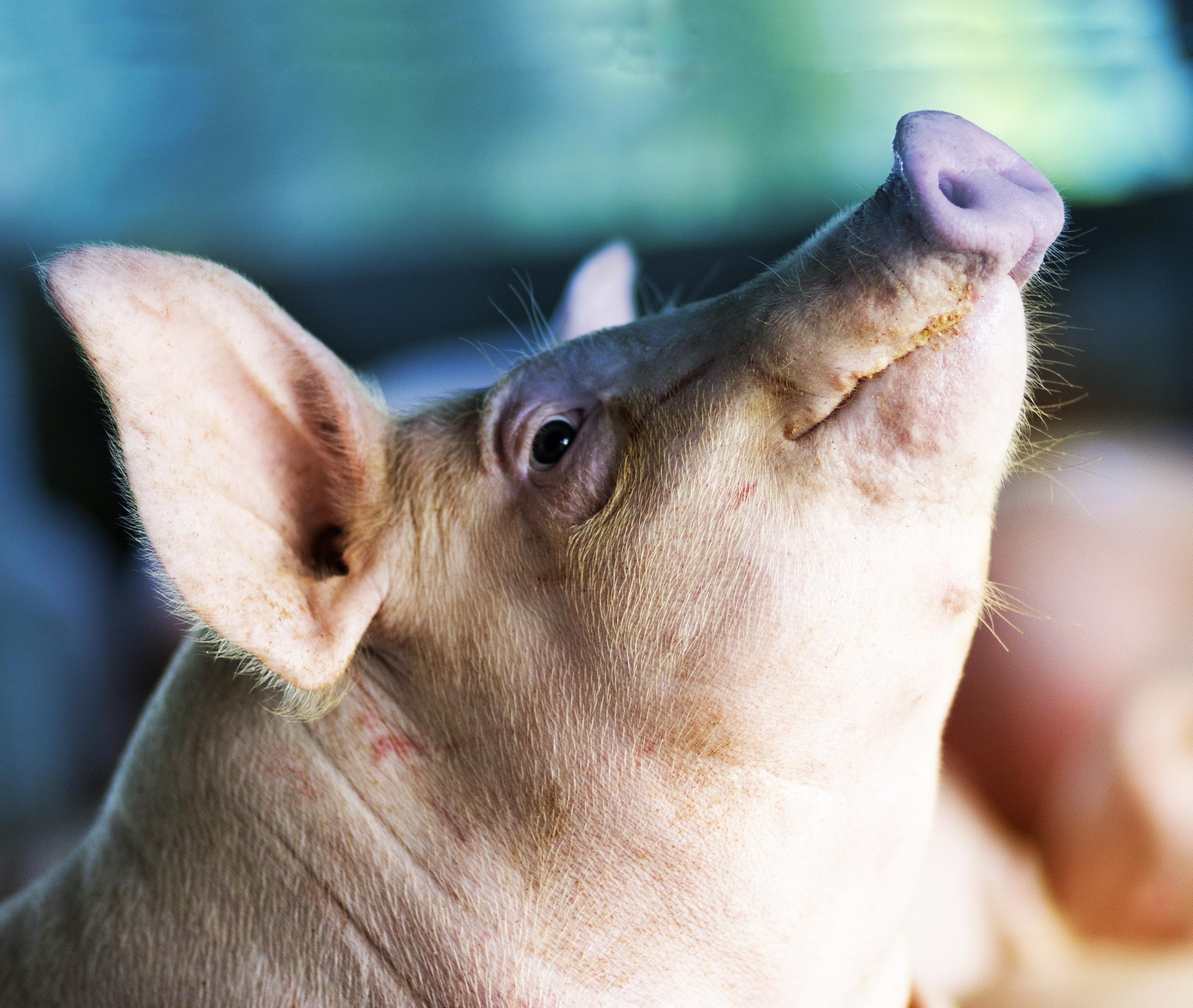
6
Stress is Natural ≠ Stress is Good
When your ladies have their feelings ignored, stress is the most common manifestation. Stress is one of the leading causes of many of the reproductive issues you work so hard to minimize.
Stress doesn’t “just happen”, it is a natural occurrence or response; but just because it is natural doesn’t mean it is beneficial. Stress is a marker for you; an indication that something else is wrong. It can manifest itself in many ways but is usually seen in increased aggression and reduced reproductive health. Stress is never the problem! Whatever is causing the stress is!
Stay with me and we will get to the heart of a few keys issues surrounding ESF feeding strategies and how these strategies can be used to mitigate feeding stress.
‘Tis
The Season for Overeating
I’m writing this between Thanksgiving and Christmas, so consumption of food is somewhat on my mind. Controlling my own intake is also rather challenging. We have all been told for years to eat slower and pause between helpings to reduce our overall intake.
I knew the following concept, but admit to Googling the term to make my point.There are a few triggers for satiety, but the most obvious is the fullness of your stomach itself that sends signals to the brain that all is well. The beginning of digestion is also key as it generates hormones that signal the brain in a positive way. But when you eat too quickly your stomach doesn’t have time to send the correct signals before it is too late, and you’ll likely overeat because you still feel hungry. Most of us can recognize this unsatisfied feeling and know if we wait a bit, the full feeling will set in and we’ll be fine. Sows unfortunately do not have this awareness and need a different approach.
Satiety in Sows
This common principle of satiety should be understood and used with sows to their benefit. When we feed a sow more slowly, and with enough water, her stomach starts to send the “full” signal to her brain before she has even finished eating. Eating slowly also means that digestion has begun before she is done consuming everything, which releases hormones that will alter her mood and help her feel full.
These same hormones are why we want to take a nap after Sunday dinner... and why she should want to take a nap after eating. If we feed her slow enough, she’ll be willing to leave when asked, and will want to take a nap before
ever thinking of checking out the station again. (Assuming a well-designed pen layout that separates the entrance and exit of the ESF feed station).
Lori Thomas, a PhD candidate from K-State, had this to say regarding the current research on sow aggression and feeding.
“As the industry has been transitioning to group sow housing and group gestation pens, ample research has been generated looking at sow aggression and stress factors. Research has indicated that adding fiber to gestating sow diets can increase gut fill and reduce aggression in pen gestation. This is a similar concept to satiety; allowing the sow to feel full and satisfied by increasing the amount of time available to consume her daily allowance of feed.”
Research shows, well-satisfied sows are less aggressive.
Feed to Water Ratio
Water is a key element to improving the sow’s interaction with the feed station. Water aids in consumption and increases the volume (not amount) of the food being eaten, thus adding to the full feeling; and most importantly it will help digestion begin. It is an absolute must that water be added to dry feed in an electronic sow feeding system. The water to feed ratio should be checked and adjusted as needed and verified regularly to ensure water pressure or feed density has not altered the ratio.
So how do you find the perfect ratio of water to feed to make sure your sows are happy?
A good mixture of feed and water is easy to check. Simply collect a single dispensing of feed as it is metered out and a single dispensing of water. The mixture should remain watery for 20 - 30 seconds while being mixed in your hand. Feed, whether mash or pellets absorbs a lot of water but if it still has some available water after 30 seconds of mixing, the ratio is good. Below is a picture that shows an example of dry feed (left side) and feed with enough water added (right side).
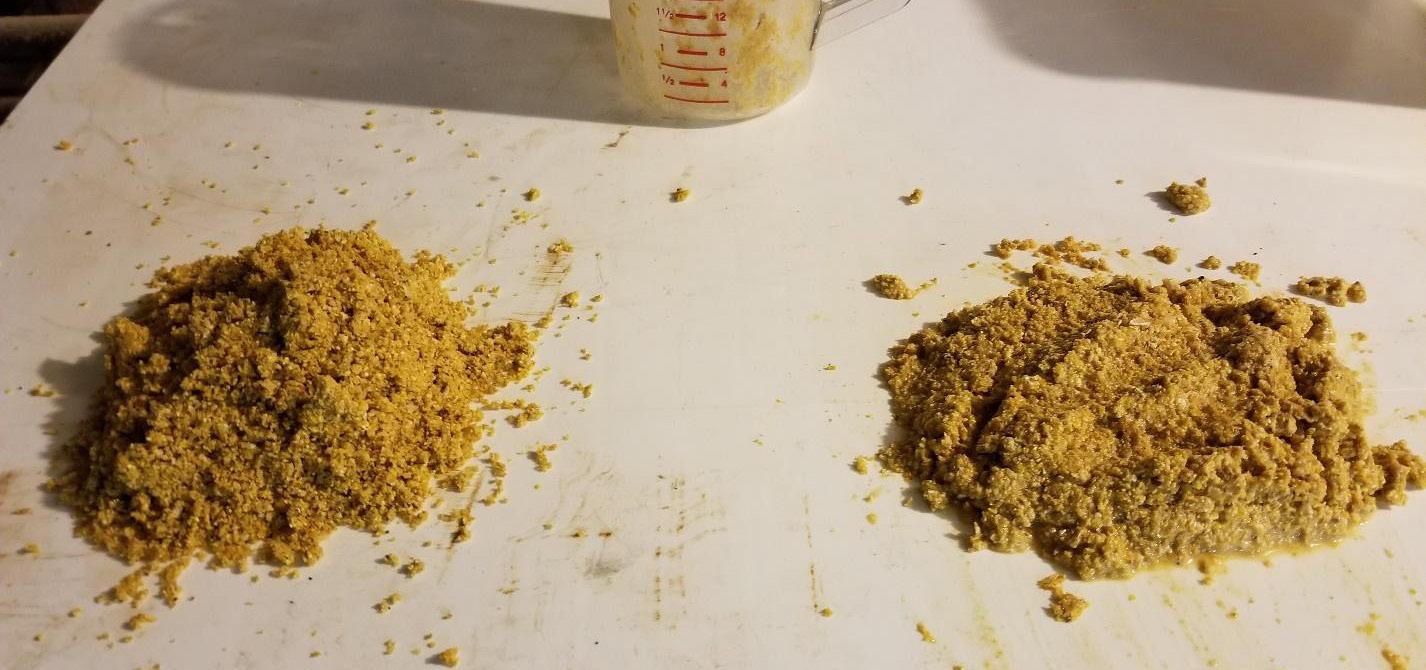
7 New Standard Hog Update 2017
Lori Thomas had this to add, “Most gestation diets are fed in meal form. By adding water when dispensing feed, palatability increases as well as feed intake.”
A Case Study
Recently, we consulted in a barn that was struggling to get their conception and farrowing rates up to where it was profitable. Upon visiting the site, it was quickly apparent that the level of activity around the entrance to the feed stations was extremely high, even during what should have been off-hours for feeding.
The gathered animals numbered about 3 times the number of stations. When there are this many sows in line, you’ll invariably have issues with tailgating into the station entrance, increased aggression in those waiting, and a high level of noise.
When we examined the feeding strategies of the barn, we found that the dispensing rate for feed was at 220 grams per minute. With a ration of ~2.2kg (2200 grams) total, this would set the time for consumption at 10 minutes. In practical experience, we know that this is not long enough to achieve our goal of satiety.
We reset the dosing speed on the feed plan to 160 grams per minute, thus extending the consumption time to approximately 14 minutes. The water dosing amount was also checked and corrected.

The Results
This simple change in that barn only took about 4 days to produce results. The noise level dropped dramatically, the number of animals waiting (even at peak feeding times) was under 1.5 times the number of feed stations and the tailgating virtually disappeared. Over the course of several weeks, conception rates are much higher and high levels of pregnancy loss are no longer an issue. All of this can be attributed to one factor.
Back to Sow Aggression
An ESF station, no matter the design, must be shared with other sows or gilts. If sows are hungry, they are not very good at sharing. The objective of slower ESF feeding is to feed the sow or gilt in such a way that she has become sated before she is asked to move along and share the feed space.
If she is still hungry and looking for more food or licking the floor, she will dig her heels in when someone else tries
to move her along. This will be the beginning of agitation and stress and will snowball quickly within your herd. Eliminate this one point of potential stress and you will see dramatic results!
Your Girls Deserve the Best
Considering the feelings of these ladies you work with can be a wonderful asset if employed appropriately. Understanding the importance of minimizing sow stress and maximizing her production potential will also explain why we feel a pass-through feed station is far superior to any other method of feeding in a large group.
With a pass-through feed station, we are able to control the intake of each gilt and sow, allowing for them to have their own space to eat without competition from others. When she is full and sated, she is perfectly okay to leave when someone else wants to enter. And the one entering does not have to wait for her to back out.
Your girls deserve the best and will reward your attention to how they feel with better health and improved productivity. So back to my original question... when is the last time you considered the feelings of your girls?
8
Drool-Worthy Meat Candy
It is that time of year when we are all invited to tons of cookouts and parties and always expected to bring something along. Don't get stuck in the cookies, or chips and dips rut! This chocolate covered bacon recipe is as delicious as it is easy. We promise you will be the talk of the party if you follow these easy steps!
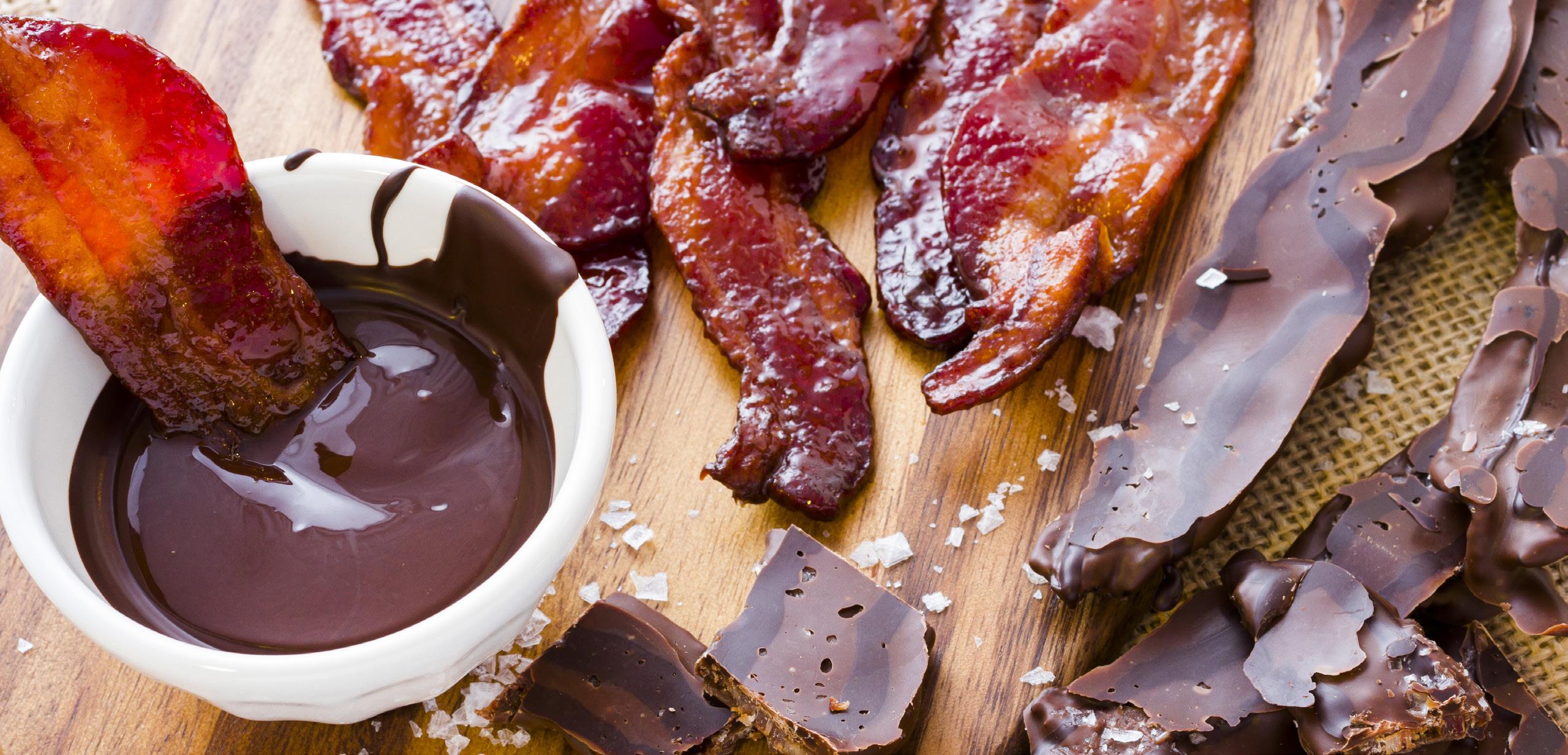
Ingredients:
12 slices of thick cut bacon
1 cup of semi-sweet chocolate chips
1 tablespoon shortening
Optional: additional toppings such as sea salt or cracked black pepper
Kitchen Tools:
12, 12 inch wooden skewers (soak well in water before using)
Raised rack in a baking pan, or foil lined baking pan
Microwave-safe bowl
Basting brush
Wax paper-lined baking sheet
Yield: 1 dozen
Directions:
Preheat your oven to 400°. Weave each of your bacon strips onto a 12-in. soaked wooden skewer. You want the bacon to be well supported by the skewer so you can easily cover it in chocolate once it is baked.
Place bacon skewers on a raised rack inside a baking pan (or on a foil lined pan). Bake until crisp. This should take about 20-25 minutes. Set bacon on paper towels to drain and cool completely.
In a microwave-safe bowl, melt the chocolate chips and shortening, stirring until smooth. Brush the coating onto both sides of the bacon strips; sprinkle with optional toppings if desired. Place on a wax paper-lined baking sheet and place sheet in the refrigerator to set.
9 New Standard Hog Update 2017
Comparing Hog Pen Panels: Polypropylene vs PVC
Installing new hog penning and gating systems into your existing or new swine barn has a large impact on the quality and efficiency of the barn. When deciding what products to install, you have to make tough decisions on the strength and lifespan of the panels, as well as the health risk each presents to your animals. Read more on how polypropylene panels compare to traditional PVC panels when it comes to hygiene and biosecurity, product strength, and environmental friendliness.
Hygiene and Biosecurity
Internal Cell Structure
Traditional PVC hog pen panels consist of internal tubes that run through the entire panel. Having these open tubes allows dirt, water, and other substances to more easily enter the panel. These substances can stay trapped inside the panel if not cleaned with extreme care, increasing the risk of breaches in biosecurity.
Polypropylene panels, on the other hand, are made up of square sealed cells and have an internal cell structure of 2”/4”. This ensures that all sides of the panels are always closed, even with customized, made-to-measure, panels. This cell structure will not allow harmful substances to leak into and stay trapped in the panel.


allows you to clean and remove stains as well as remove any viruses and bacteria so they don’t hang around and infect your animals.
Cleaning Panel Surfaces
Polypropylene hog pen panels are non-porous making them easy to clean with high pressure water. They will not trap manure or any other substances in the surface. This
No internal pollution. Panel closed on all sides.
PVC paneling has come a long way in this aspect, but American PVC’s properties are not quite as advanced yet. The molecular structure of PVC paneling is not as tight. This is more noticeable over time as the panels have had more contact with manure. Over time, the panel surfaces break down and become contaminated as substances lock in and are not able to be removed.
Panel Strength
Because PVC penning is fairly brittle, it typically shatters upon contact more easily than polypropylene. When comparing the Izod Impact Strength of each product, you will find that polypropylene panels hold up to impact much better. If needed in boar pens or other places where
10
you need stronger panels, you can find polypropylene panels with a 2”/2” cellular structure, which are almost unbreakable.

Polypropylene is a wise investment: you will likely save money on the paneling alone if you use PVC products, but the strength of your materials has a large impact on the number of fittings you need. In the end, you will spend more on fittings and installation labor when putting PVC hog pen panels in your barn. Plus, the polypropylene panels will last much longer since they are noncorrosive and won’t be affected by your animals dung and urine.

Environmental Friendliness
With major consumer concerns on environmental issues, it is essential that the pork industry pays attention to and implements more environmentally friendly solutions in swine barns. Polypropylene is one of the most neutral plastics, being made up of only carbon and hydrogen, while PVC is about 30% by weight Chlorine. It is widely know that Chlorine is dangerous to the environment. Al-
though there’s been major progress in Europe, in the USA there’s still widespread use of lead-based stabilizers in the creation of PVC. This lead can be highly toxic both in the product’s life cycle and after it is thrown away. When PVC panels are disposed of or caught in an accidental fire, they produce toxic byproducts. Again, PVC panels do not last as long as polypropylene, so they will be disposed of more often, adding more harmful waste to the environment.
Polypropylene is also produced from a gas called propylene monomer, which is a byproduct of the petroleum industry. Before producing this material, it was burned off into the atmosphere, adding to already existent environmental issues. Producing polypropylene recycles potential greenhouse gases and creates a strong, long-lasting product. Also unlike PVC, when polypropylene hog pen panels finally reach the end of their life cycle, they are 100% recyclable.
Featured Research:
Identifying Pig Personality Traits in Group-Housed Sows
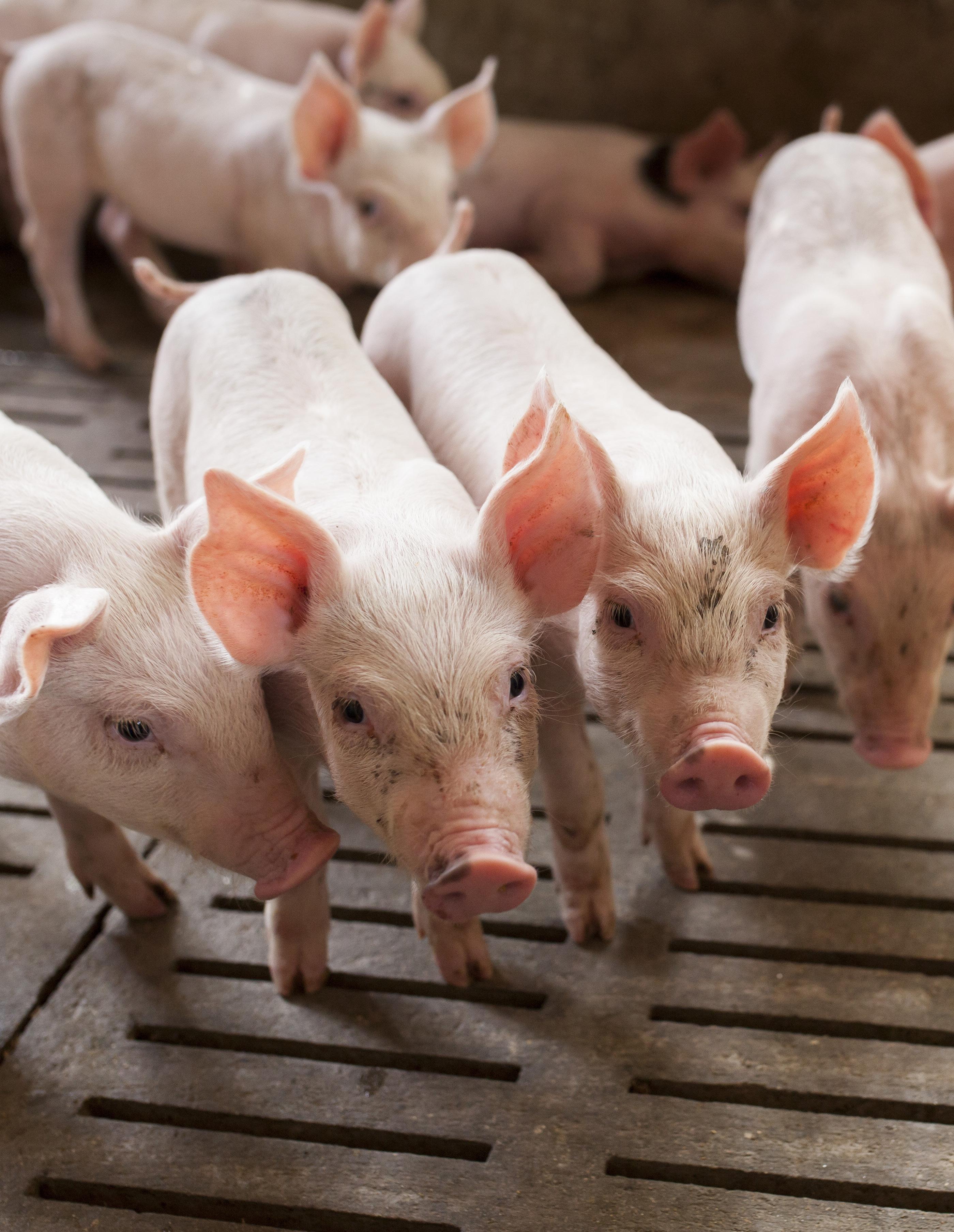
Hear from Kristina Horback on her latest research, identifying pig personalities and how they relate to aggressive behaviors in a group gestation pen.
 Kristina M. Horback, Ph.D. Assistant Professor at UC Davis
Kristina M. Horback, Ph.D. Assistant Professor at UC Davis
Meet Kristina Horback
I am currently an Assistant Professor at UC Davis in the Department of Animal Science. My background and my previous research is focused on animal behavior and cognition. I worked for about eight years with primates and dolphins on information processing and communication; some of those animals were in captivity, and some of them were in the wild. I essentially looked at social behavior and how animals are communicating a threat or compliance with the group around them. I switched to swine research when I went to the University of Pennsylvania’s Veterinary School. There, I started working with Dr. Thomas Parsons, who worked exclusively with ESF barns. For over a decade, Dr. Parsons has helped swine producers to convert their sow housing from stalls to pens by providing advice on resource-based changes, such as barn design, feeding systems, or strategies of mixing individuals after breeding. I have focused the majority of my research on animal-based measurement, such as personality traits or emotional state, specifically in piglets, gilts, and sows.
Discovering Pig Personality Traits with Simple Behavioral Tests
Dr. Parsons hired me to investigate the existence of personality types or temperaments in group-housed sows. We were trying to identify behavioral traits in the sows which were consistent over time. In one large study with 50 females, I carried out different behavioral tests looking at social isolation, threat from a human, moving down a hallway, or how sows interact in a new group. We put them through a battery of tests so they could show their true colors, and we were able to extract the most relevant behaviors to combine into three traits: interaction with environment (called exploratory), interaction with humans (called avoidant) or interaction with other sows (called aggressive).
Sows with high ratings on the exploratory trait will smell every nook and cranny when placed in a new pen, and they’ll go around make snout-to-snout contact with almost every other sow in that pen. Sows with high ratings for the avoidant trait do not engage with humans in a familiar or novel environment, and will keep a large flight-distance from humans when being moved around a barn. Sows with high ratings for the aggressive trait will start and win more fights than other sows when mixed into a new social group, and they will be more aggressive toward humans 24 hours post-farrowing when their piglets are being handled.
I have been identifying different consistent personality traits or temperaments in sows over time. I kept the sows in their second parity and then they went off to farrowing. When they came back to the group gestation pen, they were all consistent in their behavior.
I followed up this initial study with a study of the development of these traits. In this study, I followed a group of 40 gilts from birth, looking at weight gain, teat rank, fighting and playing in the farrowing pen. Then I followed them through the weaning, grow, and then they were put into the barn as replacement gilts and eventually reproducing sows themselves. I’m just submitting that study for publication and I’m looking at a lifetime productivity or illness as it relates to these personality traits in the females.
So What Am I Trying to Find?
My major goal is to increase awareness of individual differences in sows. You see when there are animal care takers that have that knowledge: “this sow, she’s an aggressive sow, or this one, she’s little bit more shy.” I’m trying to take that intuition of animal care, and quantify it. If we can do that, then maybe we can look at the compatibility of the group or understand that some sows may be more prone to have stomach ulcers because they are the stressed, anxious type, and understand that we need to pay attention to these individuals because they are more likely to be suffering from illness. Traditionally, farmers have said, “Well I’m not going to breed her, you remember how aggressive she was.” My goal is to actually find that out, is that inheritable or not? I am trying to identify personality traits that we can relate to each sow’s health and the welfare of the group.
Finding Predictor Traits Among Piglets
When we have producers visit and they want to know what I do, I explain that we are trying to find predictor traits. You can have a backfat phenotype or leg lameness phenotype; that is something that is being looked into for both sows and boars. What I am looking for is a behavioral phenotype. If we can find early signs of aggression or stress vulnerability in piglets, we can choose not to insert them into the group gestation pens.
The biggest threat to group housing is sow aggression; there are those that will harm others or harm themselves, which can lead to abortions, injuries, and even mortality. Perhaps if we can pick those out that are hyper-aggressive, we can reduce the number of aggression issues within group pens. There’s even a
13 New Standard Hog Update 2017
Cont. Next Page
chance in the future we will move away from farrowing crates. We need to know about sows that are far too aggressive towards humans at farrowing time, or are unresponsive to their piglets’ squeals when they are being crushed by the sow’s weight.

My research suggests that young gilts which squeal and struggle when held by humans (or restrained) will typically have a similar and consistent reaction over their three or four weeks in farrowing. When these pigs grow up, they tend to be the more aggressive ones in the gestation pens.
All of the behavior tests I am using in these studies are designed to be easily transferred in on-farm testing by animal care staff. Routine piglet processing requires some animal handling for ear clipping or iron injections. Perhaps the staff can keep a record of the piglets which struggled the most during processing and check on these particular piglets for aggressive behavior in the nursery pens.
Understanding Personalities Could Make Barn Management Easier
I started all of my work in animal behavior, not from an applied sense, just to understand the species. I really just want to understand how sows communicate with one another when they are threatened or anxious. I look at the social network of sows in pens and how the sows tend to cluster in groups, or cliques (like at a high school cafeteria) and eat with their social group.
A large issue with group housing for producers is finding a certain individual. In a crate system, you know exactly where individual 2240 is located. In a group system, that adds a lot of chaos. But if you can have those behavioral metrics to know that of a certain age and of a certain type in a pen, you can find a specific sow because you know where her group meets up.
All of this could make it easier for producers to handle this big change. Consumers are then happy with all the effort that is going into taking care of the animals.
Future Personality Research With Group-Housed Sows
I am currently replicating my study of the development of personality traits here at UC Davis. I have followed a group of gilts, born in February, and half of them went to market and the other half are being cycled into our smaller research herd here at the University. My interest is going back to the basics of cognition, so I’m using some differ-
ent psychological experiments. Basically, in many species, including humans, rats, dolphins, chickens, and pigs, information processing is clouded by emotional state. So if you are in a positive state, you are going to memorize words that are a little more happy or you are going to pick up on things that are a little more positive in your environment. The same is true if you are in a negative space. If you are more anxious or fearful, you are going to say “What was that?! What was that?!” This is called a cognitive bias; it is a preference for the mind to process certain information.
I’m running tests to look at that cognitive bias in our sows, and I’m learning that some of those more aggressive, bold individuals may actually be in a more positive state. They may be having a higher mental welfare which would make sense. When I assess the emotional states of the sows that are lower on the totem pole (non-aggressive, non-active), at any given time they are much more negative. Again that makes sense. They’re looking for the next threat around the corner or they’re anxious.
I’m building on this work and trying to compare this personality and mental state with other species. I’m starting to organize projects to investigate temperament in sheep and cattle to investigate how such behavioral traits relate to stress response, weight gain, and illness prevalence. It all goes together. If you are in a really high stress state, you probably aren’t going to gain weight because you will not be spending time eating (but will be spending time looking over your shoulder), and you’re also going to be more susceptible to diseases in this hyper-active stress state.
Animal Welfare For the Industry
With my personality research, I’d like to help farmers engage more with their animals, not to say I’m an expert because they certainly know their animals better than I do. I’m interested in animal welfare for the industry not against the industry. Given our ethical responsibility as animal care takers of this domestic species, and the large need to produce a robust and healthy protein source, I hope that my research can help both the animal and the producer.
14
Find Your waY through the maze

Start Finish
FortheKids
Did you find your way? Turn your magazine upside down to see the answer
New Standard Hog Update 2017

Remember When Preparing Gilts for an ESF Barn
Four Rules to
The success of your ESF barn, upon startup and during regular operation, depends on a few key factors. One of the most important of these is how you train the gilts that are coming into the system, and more specifically, how you prepare the gilts overall.
In this article, we will walk you through the process of preparing, training and acclimating gilts, from weaning through training and further on into breeding. Depending on the flow of animals into your loose sow housing facility, you can incorporate the following four rules at any point in the life of the gilt.
Get to Know Your Animals
To most it seems like a waste of time, but spending time getting to know the girls can pay dividends down the road when you’re asking them to trust you when entering the feed station for the first time. Pigs are social animals, and this is a real and significant trait that we need to recognize and use to our advantage. The sooner your staff starts interacting with the animals, the easier the transition to the group sow housing barn will be. If someone in the loose sow housing barn is given the task to simply spend time with the developing gilts for a short period each day, you will find that they will be much easier to work with. A good way to approach this is to have a barn staff member attempt to make some of the girls his or her pets each day.
Let Curiosity Lead the Way
Along with these highly social traits, another of the gilts’ traits that should be used to its fullest effect is their natural curiosity. When a pig enters a pen for the first time, she will nose around and will map out the pen for her needs. There are three main areas in a pen for the pig. First, the pig will seek out the area that they can get food and second she’ll determine the area where she will lay and rest in. Once she has determined what those areas look like, the area that is left over (typically the least comfortable area) will be used for dunging. Social and recreational areas are interspersed within the three areas, although these areas tend to not be as well defined and occur in any area where the pigs can mingle.
We recommend allowing the gilts to freely explore the GDU pens for the first time without being forced into any certain area. When exploring a pen to determine where the three main areas are going to be, the gilts will usually look for feed and water first. We can use this searching and exploring to begin to get them comfortable with equipment in general even when they are fairly young.
Carrots, Not Sticks
A key hire for your group sow housing barn is the person who works with the gilts while they are developing and especially during the ESF training process. Working with sows and gilts can be quite rewarding if a person enjoys interacting with and caring for animals, and this exactly the kind of person you need in a training position. You need someone who is going to treat the animals like his
or her pets. This person will train the girls by comforting and rewarding them for positive actions rather than punishing them for negative actions.
During training, the gilts are asked to learn a lot of new things: where and how to eat, how to use a pen layout that is designed for social group development and how to be in charge of their eating times and patterns. At times, this can be frustrating for the pigs as well as the barn staff working with them. A person with the right attitude will keep their stress levels low, which in turn keeps the stress levels low among the girls they are working with. In this area of a barn, it is vitally important that the training procedures for the gilts be imparted in a gentle fashion and not forced upon the animals. This approach will lead to better demeanors and better habits in the animals and the staff.
Promote Good Habits
Once a gilt has been trained to use the ESF feed station, the next step is to have her embed what she has learned and promote good use of the large pens. It will take approximately 5 - 7 days to teach gilts how to use the stations by themselves, but it takes 2 - 3 weeks to foster proper use of the pens. When they enter the pen for the first time, they have come from a pen that didn’t really develop much in the way of social structure. This is the time to promote that. The training pen(s) should be set up as much as possible like a regular ESF pen. The pen should have nesting areas sized for a regular social group of gilts and have the traffic patterns, watering areas and (if incorporated) a heat detection unit all placed similarly to what they will encounter once they graduate to a bred gilt pen.
It is in the second and third week of training that the gilts learn that they are in control of their own feed schedule and can access the feed stations and receive feed without help. They learn to separate themselves into groups, and they start to establish defined areas of the pen for different uses (feeding, lying and dunging). It takes a couple of weeks for these things to be defined and embedded as quality habits that the girl will retain throughout her time in the barn.
17 New Standard Hog Update 2017
The Evolution of the Farrowing Crate
Farrowing crates have been around a long time, and pigs have been around longer. Check out this article to see how they have evolved!

Way Back When
Pigs have been around forever. In fact, scientists have found fossils that indicate pigs could have been roaming the earth 40 million years ago! Pigs were domesticated in China around 4900 B.C., and around 1500 B.C. in Europe, but what we know today as the farrowing crate didn’t get its start until hundreds of years later.
The earliest known example comes from the UK in 1807 with “Mr. Pattinson’s Pig Case”, an antiquated equivalent to today’s farrowing crate. This was the first way technology was used to produce happier, healthier piglets, just as we try to do today as technology continues to advance.
The Good ‘Ol Days
Did you know that the farrowing crate was actually developed before gestation crates were? Well it’s true! By the end of the 1960s, farrowing crates were extremely common on hog farms across the United States and Europe. This was the humble start to much of the advanced technology we use today.

Even as early as the 1960s, there were producers interested in staying up on the latest technology.
Today
Following the same general concept, farrowing crates have continued to become more and more in tune to the needs of the sows and piglets. Many modern crates are designed to keep the sows at cooler temperatures than their piglets, as well as keep the piglets dry to avoid the spread of disease. Many modern barns are even equipped with advanced, adjustable anti-crush bars so that the sow has more room to move freely, all without without endangering her piglets.
ESF technology is also available in farrowing barns and can be a great addition to maximize your sows’ recovery times. Research has shown that sows who are well fed during lactation go into estrus more quickly and release more eggs when they are in heat. Nedap Farrowing Feeding Systems, feed sows their rations over multiple meals each day, allowing them to get maximum feed intake for their exact condition and stage of lactation.
18
Display (LCD) with capability for remote touch screen interface for up to 20 scales


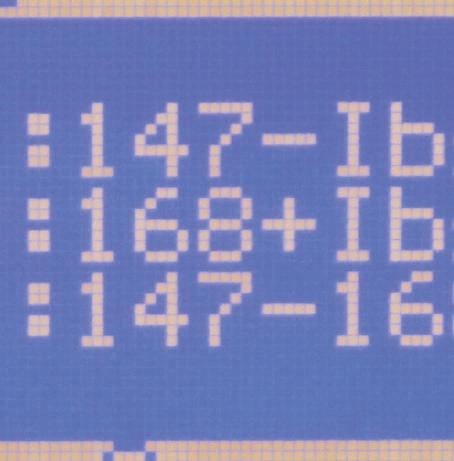






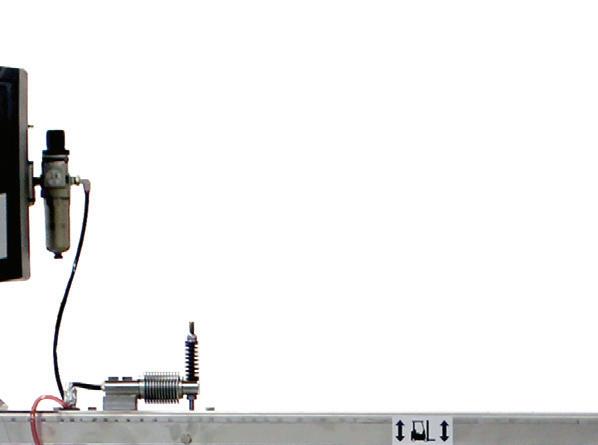

Solid sidewalls with LED light to keep pigs moving forw ard Single load cell and weight bar linkage
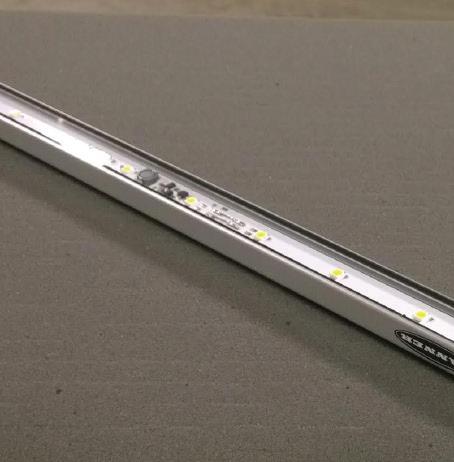


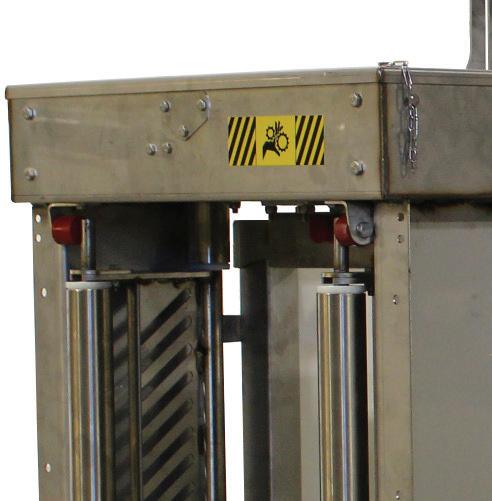




 Rugged construction and design
Durable Traction Coating
Larger Diameter
Gate Rollers
Precision Assembly with oversized cylinders
Rugged construction and design
Durable Traction Coating
Larger Diameter
Gate Rollers
Precision Assembly with oversized cylinders
Precision Feeding in Gestating Sows, Or Sow Weight Watchers
By: Lori Thomas, PhD Candidate at Kansas State University
Feeding gestating sows is arguably one of the most important tasks within the sow farm. I know what you are thinking… anyone can feed a pig. And although this is likely true, if you want the best performance for your sow and her piglets, precision feeding is required.

So, what is precision feeding?! It’s quite simple really. You want to feed the gilt or sow just enough to meet her daily nutrient requirements. Over or underfeeding can negatively impact sow reproductive performance and longevity. Is she too skinny? Too fat? How do you know?!
The Problem with Body Condition Scores
Most swine producers evaluate gilts and sows based on body condition scores (BCS) and use these scores to then set feeding levels. The scores range from 1 to 5, with 1 being extremely thin and 5 being extremely fat. Females can be evaluated in individual stalls or pens. Producers evaluate females individually and increase or decrease set feeding levels with the goal of obtaining females with a BCS of 3 upon entry into the farrowing house.
The problem with BCS is they are subjective to the individual giving the score. For example, when I was working in production, I would walk through the gestation barn every 2 weeks with the breeding manager and he would stand behind the crate evaluating females and telling me (in front of the crate) to adjust the feed up or down. When he was out of town, I was behind the crate doing the evaluations. What if I called a sow a 5 when he would have called her a 4?
I was on a sow farm this summer and the same

situation was occurring in pen gestation. What one may call skinny the other may call ideal. Generally, the extremes are the ones we can agree on (1’s and 5’s) but as you can imagine, this makes precision feeding a challenge. So, what can we do?
Backfat Measurements, Are They Realistic?
Backfat measurements can be used as another method for evaluating sow body condition. Backfat depth is measured at the P2 position (last rib, 7 cm from the center line of the back).
The Lean-Meater (RENCO, Minneapolis, MN) is relatively inexpensive and is thought to provide a more objective method for determining body condition score. The greater the reading, the greater the backfat, the fatter the sow.
The challenge here is time. Obtaining sow backfat in a commercial sow farm takes time. To obtain an accurate reading, in an ideal world, the sows hair would be clipped and her skin would be free of fecal material, paint, etc. Get real! Sow farm crews are busy enough as it is, now you want to send the breeders out with a backfat probe? Not going to happen.
Although backfat measurements are an improvement to evaluating body condition in comparison to BCS, they must be done correctly and are too time consuming for producers to apply. So again, what can we do?
Weight Watchers Could Be the Answer!
Female bodyweight is another means for
determining sow body condition. That’s right, weighing gestating sows! Just like us, we hop on the bathroom scale to determine our body weight. We know where it should be and adjust our habits appropriately to alter our bodyweight. You can do the same thing with sows.
There are electronic sow feeding systems that now have the ability to incorporate a scale into the system. The producer can then obtain daily or more appropriately, weekly body weights on gestating sows. Is she gaining weight? Losing weight? If she is a pregnant sow we most certainly hope she is gaining weight or something is wrong!
The scales are able to fully integrate with the ESF system, identify the sows, monitor weight changes and develop individual growth curves. This is extremely advantageous as research has provided us with guidelines to what gilt and sow body weight should be based on parity and stage of gestation.

The scales can be used to fine tune sow feeding in
ways the BCS and backfat measurements can’t. Although calibration is required, generally they require little attention from the farm crew and are built to withstand the force of heavy gestating sows. From a research standpoint, the use of these scales provides us with the opportunity to expand our knowledge regarding the gestating sow and spot problem areas.
Optimal Feeding for Optimal Animals
If you take anything away from this article, I hope you understand the importance of precision feeding in gestating sows. Whether you choose to evaluate body condition with a visual assessment, backfat, or body weight, it is important to know the pros and cons of each method and why variability may exist.
Accurately feeding gestating sows will allow for them to enter into the farrowing house with an optimal body condition and nurse a litter of 13+ piglets for the next ~21 days. Mama’s job is extremely important, without her, we have nothing! Thus, precision feeding of gestating sows will help prepare sows for a successful lactation.
Arno van Brandenburg is the eminence grise of the electronic feeding industry. His name is well known throughout the hog world, and working with Nedap since 1984 has given him an insider view to the rise of many new technologies that have changed the swine world for the better.

When van Brandenburg started his work in the industry the technical side of pig farming was still very limited. Ventilation was pretty much the only mechanized thing in most sow barns. There were a few food delivery systems on the market that had just started, but they had not yet gained market share.
At the time Nedap was known for its expertise in electronic feeding systems for cattle, not pigs. They had just made the very first sow feed station, and they were looking for a person who knew something about sows. When van Brandenburg started at Nedap, their ESF feeder was simply an electronic cattle feed station that had been lowered. They initially used a collar system around the sow’s neck because that was what was used for cattle feed stations, but they quickly realized that the sows were losing their collars due to their necks being as thick as their heads. They also noticed that sow biting behaviors necessitated a rear door
to protect them from other waiting sows. “We added the back door and it was working for groups of 8 to 10 sows, but when we got up to 20 sows on the system it stopped working well,” van Brandenburg said, “that is when we first realized that we would need to develop a forward exit on the sow feed stations.”
As electronics became smaller and smaller, they were able to switch to smaller ear tags, landing on the current size in the mid 1990s; but that wasn’t the end of the struggles to make ESF work in the hog industry. As the world looked toward the new millenium, Nedap executives started to doubt if there was a future in commercial electronic sow feeding. The system was slow to gain acceptance and still not as effective with large groups as they had hoped.
Change came when a company out of Holland experimented with a new design that put several feed stations in a row right next to one another in the same pen design, allowing for fewer sows per feed station while maintaining larger group sizes. Combining this with their knowledge of forward exit, Nedap landed on the concept of a shared central passage and the capability for central separation. “At that moment it was a big change for us, because we knew that the system would work better and better all the
FEATURE: ARNO VAN
THE EMINENCE GRISE OF THE ELECTRONIC FEEDING INDUSTRY
BRANDENBURG
time as technology advanced,” van Brandenburg said. “And that was the beginning of Nedap as we know it.”
With an effective electronic feeding system firmly in place, attention switched to creating even more effective barn layouts for workers and sows, improving walking lines and passages and developing data collection software for farmers. Watching the ESF industry grow by leaps and bounds over the past 20 years, van Brandenburg has seen the focus of the industry gradually shifting.
“You know it is interesting because in the beginning we were talking about group housing as the emphasis, but now we are talking more about individual feeding as the emphasis. With individual feed, you can get the maximum out of each individual animal.”
Maximizing Your Animals
Getting the maximum production value out of animals while maintaining a high level of animal husbandry has always been a passion for van Brandenburg. In his view, farmers want to be economical, but most also want to treat their animals well. As pressure for group housing came into the picture in European markets over the past 20 years, European farmers, and now Canadian and even US farmers, have been pushed to change from the stall barn model to group housing. The model works well, but it is a significant change for many farmers, both in equipment and mindset.
What began as an end-consumer driven demand for more humane sow housing has morphed into a focus on not only humane housing but also precision feeding, high production, and reduced stress on the farm workforce. “We have had to innovate because we get pressure from the customer,” van Brandenburg said, “but when you find solutions to customer problems, it can make your system even better than what you had before.”
Data Makes the Difference
One of the largest areas of innovation in the past 10 years has been sow data collection and analysis. As a new generation of farmers come forward, they are bringing their expectation for technology with them. With computerized stations, advanced electronic monitoring, and state of the art software, sow data can be accessed in real time allowing producers to take quick action when they spot a problem in the sow barn.
“It can be hard on farmers who are used to individually treating the animal in stalls,” van Brandenburg said. “They are used to doing visual inspections of all the animals, looking to see if a pig isn’t moving and they should treat them. But as you give a lot of freedom back to the animal, she is getting an even greater individual treatment due to the electronics. And you can individually treat her the whole way through her lifespan and still have her rooting around in a big group.”
One way van Brandenburg has seen this play out is with sow weight monitoring which is growing in popularity in western Europe. In January, van Brandenburg received a call from a new ESF client who said he was worried because while everything else was working perfectly and the sows were happy and peaceful, he noticed that out of his 200 sows, he had 20 who were on the attention list due to weight loss week over week. After confirming that the farmer had checked that the scales were in working order and reporting correct weights van Brandenburg congratulated him, “You’ve discovered you have the wrong feeding curve inside your system because they are not eating enough. An animal in pregnancy should grow around 3 kilos a week.” The farmer asked what could be done and van Brandenburg offered to send him better feeding curves from another customer. Within a week the weight issues had resolved and his sows were back on track. “So that means that because he knew that something was not right, he was able to give it immediate attention and address it.” van Brandenburg said. “Otherwise he may have seen it two months later in the farrowing pen with light piglets. With a lot of figures in the pig business, you record what you did after it has happened and you cannot change it anymore. So if you have 15 born alive, that is nice but it will never be 16 because you cannot change it. With ESF, we try to focus on giving the farmers as much immediate information as we can so they can improve their efficiency of producing piglets, achieve better piglet weights or even fatter finishing pigs.”
Immediate access to data is van Brandenburg’s vision for the future. “I think we are now at the beginning of seeing data become a focus. We are only at the start of the new generation of new possibilities. This is something which could change the world. It will change the world.”
23 New Standard Hog Update 2017
“We added the back door and it was working for groups of 8 to 10 sows, but when we got up to 20 sows on the system it stopped working well,” van Brandenburg said, “that is when we first realized that we would need to develop a forward exit on the sow feed stations.”
Can You Solve this Logic Puzzle?
visit www.newstandardag.com/puzzle for answers
Jill has hired several new people to work in open sow housing at Makin’ Bacon LLC. She wants to check on their results after their first full day at work. At Makin’ Bacon they love color coding and have given color names to their sections. Help her match each new employee with their area of expertise and section of the barn (broken down by color), as well as the number of pigs they worked with during that day.
Remember, as with all grid-based logic puzzles, no option in any category will ever be used more than once.
1. The person who is an expert in Farrowing served 25 fewer pigs than the person who works in the green section
2. Josh served fewer pigs than the worker who is in the purple section.
3. The employee who works in the red section served 50 more pigs than the employee who manages farrowing.
4. The employee who works in the yellow section served fewer pigs than Layla.
5. George served fewer pigs than Josh.
6. The worker with the expertise in insemination served more pigs than Layla.
7. Josh isn't an expert in gestation.
8. The women work with the most pigs.
24






25 New Standard Hog Update 2017 5j Marketing + Design is a team of writers, designers, strategists, and all around helpful people with experience in the ag industry who want to help your business succeed in t he ever changing world of marketing. Connect with us 855.554.8669 info@5jdesign.com www.5jdesign.com CONTENT CREATION GRAPHIC DESIGN DIGITAL MARKETING ANALYTICS/ REPORTING PHOTOGRAPHY WEB DESIGN Our services range from Web and Print design to content creation and reporting. We want to provide you with the tools to engage your audience and help your business stand out from the crowd! How Can We Help?
9
BARN MANAGEMENT HABITS THAT TANK SOW PRODUCTIVITY


 With advice from Steve Horton
With advice from Steve Horton
Steve Horton has been working with Thomas Livestock for eight years. He currently serves as the farrowing supervisor for four sow barns. In his 42 years in the hog industry, Horton has seen plenty of barn management styles and observed firsthand how that can impact worker and sow productivity. We sat down with Horton and asked him about barn management habits that negatively impact sow production. Keep reading for Horton’s thoughts.
POOR HEALTH OF ANIMALS
The first thing you need to think about in a barn is bio-security and good animal health. The foundation of this is good daily care of the animals, teamed with good veterinary care.
As a manager your job is to promote good animal husbandry among your staff. Workers have to really care. They have to get the sows up and check temperatures; they have to do what is best for the animal.
I think sometimes standard operating procedures can put limitations on workers, because as managers we do have to be concerned about cost, but the people in the barns have to be allowed to care for the animals as their first priority.
OVER MANAGING
There is always a temptation to over manage, but that can be damaging to morale. We have to keep open communication between the workers and management so that workers feel free to share their ideas and concerns and feel like their opinions matter. I never mind when people come in and call it their barn. Yes, it is Thomas Livestock, but if they don’t take ownership then we’re missing the boat.
NOT HOLDING PEOPLE ACCOUNTABLE
Without accountability it is harder for workers to see that they are doing a good job and that they are part of a bigger team. We use records to help hold everyone accountable for their job.
The people in the farrowing house are accountable for the stillborns. The people that are doing the artificial insemination are accountable for the fertility. The people that are taking care of the ESF pens are accountable for the pregnancy rate or the fallouts in

the pens. The people that are pressure washing are accountable for barn cleanliness and health. Everybody has an important job in the barn, and holding people accountable for their part in the operation helps them to see that.
We try to set goals and when we hit goals we bring in rewards. For instance if the breeding barn hits their goal of what we set for their fertility rate, we bring in candy bars for everybody. If the farrowing barn hits their goal, we bring in sodas for everybody. When we hit our goal of being a top farm in our swine management system, then we take everybody out for pizza or steak. It is all about teamwork and accountability.
PLAYING FAVORITES
Part of teamwork is not playing favorites. You’ve got to make sure you’re treating everybody fair across the board. For example, if someone asks for days off and always gets them when others don’t, that is not okay. Everyone needs to feel as important as the next guy.
If workers feel like you’re playing favorites they start talking about it and it creates divisions in the team. Those divisions can lead to poor decision making in the barn and negatively impact sow production.

NOT ASKING HOW WE CAN IMPROVE AND NOT ACTING ON SUGGESTIONS
A lot of times the workers in the barns have amazing ideas, and if we aren’t asking for feedback, we’re missing an opportunity. It is important to let your employees know that you are willing to listen and you want them to continue to think about things.
For example, in our farrowing crates we have an underlayment underneath the wire that helps stop a draft from coming up; but that didn’t used to be there. A young lady working with my boss actually suggested that we do that. We thought that it was the silliest idea because we thought it would create a more dirty area, but we listened anyway and gave her idea a chance. In fact, it has worked extremely well and we’ve added that in all of our barns now. All because we were willing to ask what we could do better and listen to suggestions.
1 2 3 4 5
NOT HAVING NUMBERS AND RECORDS AVAILABLE TO PEOPLE
I’ve seen a lot of farms that keep their records contained within upper management, but I think it is important to involve all barn workers in the records. We have everything posted right up front on a board. We believe that always having it in front of them helps them to see where they can improve and understand the impact their work has on production.
We train all our employees to understand the numbers. You can put numbers in front of people, but they have to understand what they are seeing for it to make a difference. We talk about our numbers quite often, even at breaks. We usually don’t even intend to sit down and talk about it, but it is something the staff will naturally bring up at least once a week. Once you understand the numbers, you want to know what causes them and how your work can impact the bottom line.
NOT HAVING ENOUGH GILTS
When visitors come through our barns they will sometimes remark that our gilt replacement is quite high. We are probably higher than a lot of other operations, but when it comes down to it, if you don’t have enough gilts coming into your herd you’re going to end up keeping sows that you wanted to get rid of. That’s going to hurt your numbers in the end. Having gilts ready to replace sows is a very important part of our success.
NOT HAVING THE GILTS PREPARED
Prepared gilts are calm gilts. If you don’t take the time to acclimate them to where they will be going and train them with the ESF system, then you are causing a lot of unnecessary stress on your herd and your staff.
We bring gilts in early to give them time to adjust to the system in a low-stress way. We have found that if you bring them in too late then they are not ready due to stress, and they usually won’t have as many piglets.
But that being said, the training itself is actually very simple. The biggest factor is remaining calm with them. The system we’ve set up takes it step by step, very simply, and with minimal stress to animals and staff.
NOT LISTENING TO WHAT THE ANIMALS ARE TELLING YOU
Sometimes we have our minds so set on the way we think things should go and what we are used to, that
we just don’t take a step back and see what the animals are saying. I’ve had people that are used to working with gestation crates, and as we went into the group housed ESF system they just had it in their mind as to how things were going to go. But their way involved pushing toward the goal rather than listening to the animal.
In one situation, I went into the pen and found three people trying to coax and train the animals. I went in and got the girls to go through all by myself! When the workers saw this their jaws dropped. They said, “You’re not working as hard as we were!” And I said, “No I’m not!” When it comes to working with animals it really is not working harder it is working smarter.
If you observe the sows and follow their cues, they will do the work, you don’t need to do the work. The biggest help you’ve got when it comes to pigs is their natural curiosity. Learn to embrace and listen to that and it will reflect in your production numbers.
BRINGING IT TOGETHER
Looking back, most of these tips involve listening and being observant. As managers, our role is to help guide and oversee barn production, not strong-arm or control every factor. If you take the time to respect your staff, provide excellent care for your animals, and stay accountable to your production numbers, you will see success as a manager.
28
7 8 9
6
"SOMETIMES WE HAVE OUR MINDS SO SET ON THE WAY WE THINK THINGS SHOULD GO AND WHAT WE ARE USED TO, THAT WE JUST DON’T TAKE A STEP BACK AND SEE WHAT THE ANIMALS ARE SAYING."
Ingredients: 1/3
cup honey 1/3 cup reduced-sodium soy sauce 1/3 cup teriyaki sauce 3 tablespoons brown sugar 1
Recipe from tasteofhome.com
Directions:
In a large bowl, combine the first 10 ingredients. Pour half of the marinade into a large resealable plastic bag; add tenderloins. Seal bag and turn to coat; refrigerate 8 hours or overnight, turning occasionally. Cover and refrigerate remaining marinade.
Drain and discard marinade from meat. Grill, covered, over indirect medium-hot heat for 20-35 minutes or until a thermometer reads 145°, turning occasionally and basting with reserved marinade. Let stand 5 minutes before slicing. Serve with rice.
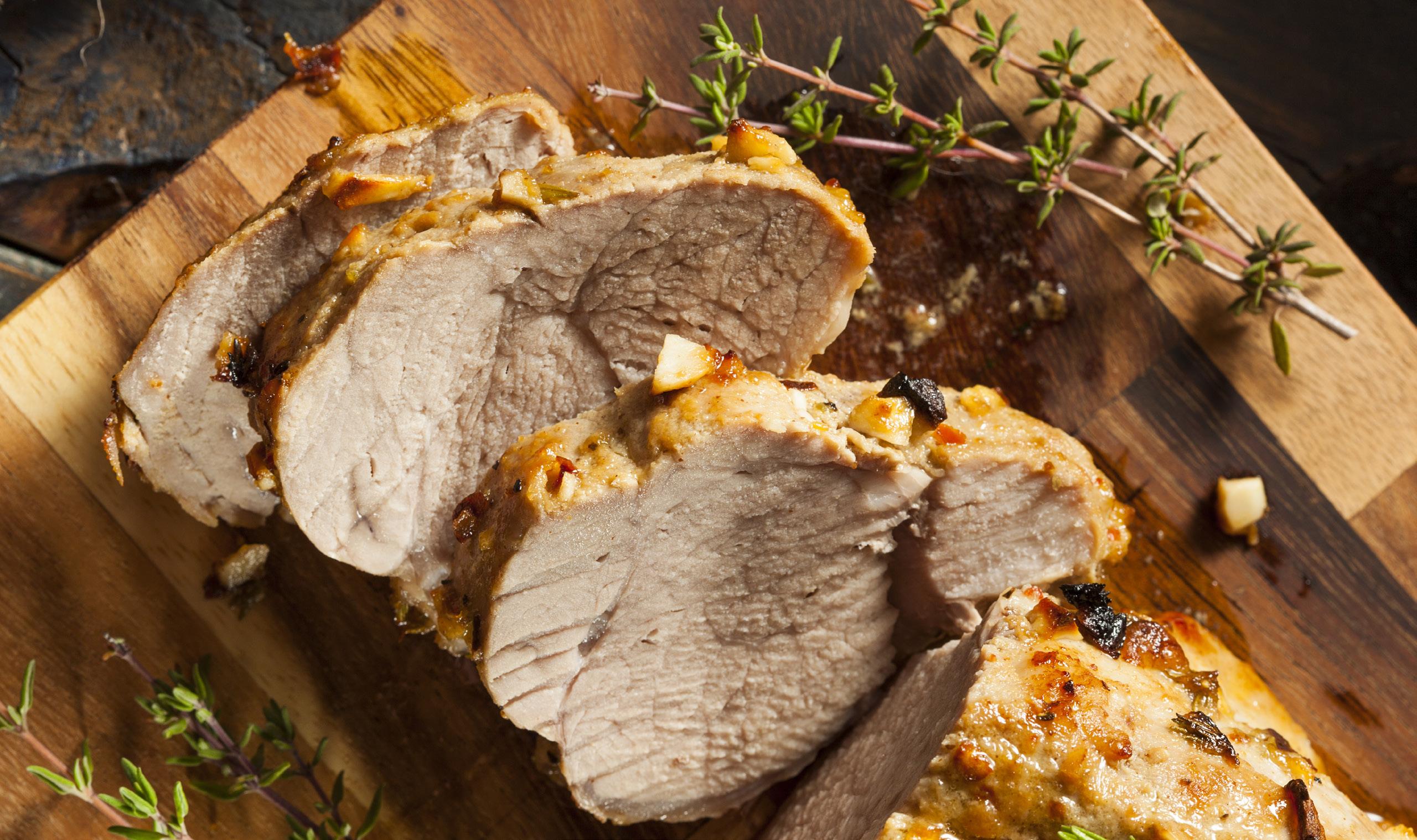
29 New Standard Hog Update 2017
tablespoon
4 teaspoons
Freeze option: Freeze uncooked pork in bag with marinade. Transfer reserved marinade to a freezer container; freeze. To use, completely thaw tenderloins and marinade in refrigerator. Grill as directed. Yield: 8 servings. Makes: 8 Servings Total Time: Prep - 10min + marinating, Grill - 20min
minced fresh gingerroot 3 garlic cloves, minced
ketchup 1/2 teaspoon onion powder 1/2 teaspoon ground cinnamon 1/4 teaspoon cayenne pepper 2 pork tenderloins (about 1 pound each)
Quick and Easy Grilled Pork Tenderloin
SHOULD I DESIGN MY SOW PENS FOR STATIC OR DYNAMIC GROUPS? SMALL OR LARGE?
By New Standard Group with comments from Dr. Jennifer Brown
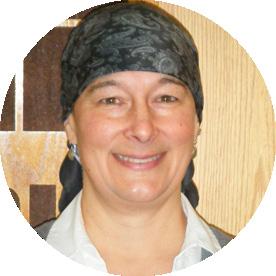
The research is in and it shows you should go with...well either really. In practice and in research facilities, both static and dynamic pens will produce at a high level with skilled management. According to a review of research by the Prairie Swine Centre, there are no significant differences in birth rate, still births, lameness, or any other major production measurements among sows in static groups and dynamic groups.
While either pen strategy could work for you, it is important to know the advantages and disadvantages of both.
Should I Go Static or Dynamic?
Static Gestation Pens
The majority of static pens are not nearly as large as dynamic pens, which can be both a positive and negative. The size of static groups depends on your overall herd size and the number of sows bred at once, as well as the type of feeding system you implement. Because they tend to be smaller, static pens may seem like they do not require as much management and oversight but that overlooks the vital task of sizing and combining animals well when filling a pen, especially in a competitive feeding pen.

Static pens also tend to be filled (and emptied) quickly with greater numbers of animals being introduced at once where dynamic pens allow trickle filling of 10-15 animals at a time. Filling pens all at once tends to produce more aggression in sows early on, but once the girls settle into their social hierarchy, they tend to calm down and the social structure remains intact for their entire time in the pen.
In practical experience, we have seen that sometimes farms opt for static pens because they are wary of new technology and the idea of training their staff on a new system. We find that some farms continue with static groups even when they would prefer to move to dynamic because they lack faith in themselves to effectively manage
barn.
Dynamic Gestation Pens
Dynamic pens offer more flexibility in a barn as you can use available space in any pen if needed. While static pens cannot have animals added to the group if there is extra space created by pregnancy loss, dynamic groups can add extra animals quite easily. Dynamic pens also make the most efficient use of space since less room is wasted on alleys.
30
a dynamic
The major question that arises in the group housing planning process relates to pen design and sow grouping strategy. Should I design around static or dynamic sow pens? And should I house the sows in large or small groups?
Typically dynamic pens require a higher level of stockmanship as these pens tend to be larger and barn staff must be able to identify needs, health issues and body scoring within a greater number of animals. With that said, small static pens (with competitive feeding) may also require a very high level of stockmanship (selecting groups based on size and condition, checking sows daily for drop-outs at feeding time, higher drop-out levels requiring removal and specialized care etc.)
Should My Pens Be Large or Small?
Just like with static and dynamic grouping, both large and small pens can work with the proper design. That being said, it has been clear that large pens make better use of the barn and tend to produce less aggression in sows. Dr. Jennifer Brown with the Prairie Swine Center, who is working with the National Sow Housing Conversion Project had this to say about pig behavior in small and large pens:
“Studies on finisher pigs show that in large dynamic groups, pigs adopt a more tolerant social behavior. When they are in small groups, they have a more defined social hierarchy, and show a greater response when mixed with unfamiliar pigs. Think of living in a big city vs a small town. When someone new enters the city, you are more passive towards them - you don’t notice and don’t care because you are used to all the people, and you can’t dominate the entire city. In small town, you know everybody, and it’s a disruption when new people enter. You try to figure them out and where they fit in your community. It’s easier to be the boss of the small town than the big city. “
Should I Group By Parity?
While the main questions people ask are whether they should implement small or large pens and whether to go with static or dynamic pens, you have to dig deeper. You should also consider grouping factors that affect sow performance and ease of pen management.
When considering your grouping strategy, you can group all parity levels together -or- you can separate your sows by parity. Separating by parity maximizes your space allocation in the barn.
Such separation is more difficult in smaller barns, but in larger herds (>1000 sows) it isn’t uncommon to find three separate groupings. Dynamic grouping by parity can be done in herds with as few as 500 sows, but at that size they can only divide into two groups effectively.
Grouping sows by parity also plays a role in pen performance. Dr. Brown had this to say about grouping sows by parity:
“Parity grouping of sows is critical for the success of competitive systems, but it is also useful in non-competitive systems. We did a large study on this question at Carthage Veterinary Services (5000 head sow barn in Illinois). We formed separate groups of low, medium and high parity sows (no gilts), and compared their performance against that in mixed parity pens. The main difference we observed was that low parity sows had significantly better backfat levels when they were grouped separately. In this study, we were also a bit surprised to see that the younger animals performed more aggression.”
Grouping by parity is not the difference between success and failure in a barn, but it is becoming clear that there are many performance and cost benefits when low parity and high parity sows are grouped separately. While this is not impossible in small groups, it is much easier and more cost effective in large groups in a large barn.
So, Which Combination is Right For Me?
There are plenty of salesmen out there that are going to tell you that only small static groups or only large dynamic groups will work. But the truth is you need to figure out what will work best for you and your staff.
From our experience, if you are building a new barn, we recommend building your sow pens for large dynamic groups that are separated by parity. Again the sows are more tolerant and less aggressive. In addition, your pens are already built with the necessary space for subordinate sows to escape from more aggressive sows.
There are a number of producers who have found that even in dynamic groups there are better interactions when P1 and P2 animals are penned separately from older girls.
In smaller pens, you will waste square footage in order to make the pen large enough to accommodate for this. Small pens also tend to bring the entrance and exit of the feed stations too close together. As we mentioned, small static groups can be successful with a highly skilled barn staff, but they won’t be as cost-effective and they will be harder to manage well.
31 New Standard Hog Update 2017
Group 1: P1-P2 Group 2: P3-P4 Group 3: P5 & up
What Do Producers Really Think of PanelTIM?
PanelTIM's polypropylene panels have taken off in the North American hog industry with their combination of lightweight materials, durability, cleanliness, and quality design. On a molecular level they are stronger and cleaner than PVC, not to mention they hold up to years of abuse, something hogs are notoriously good at providing.
Those of us in the hog building industry get really excited about products like this, but we want to give you a producers perspective on the product. We interviewed three producers from different states to see how their PanelTIM penning and gating has held up to the test of time...and pigs.
Robert Glanzer
3,000 head finisher barn PanelTIM installed 3 years ago "We've had PanelTIM in our barn for 3 years after we heard about it from our ventilation guy. We were so tired of the old style with cement walls and we weren't interested in PVC for this barn because we have had PVC in the past and it just breaks. In my experience, PVC panels last 1 or 2 years at the most. There was always something somewhere that was broken.
PanelTIM has 100 percent held up. It is an install and forget about it product. The gates work very well. Everyone that sees them is impressed with how smoothly they open and shut. The only issue I've encountered, and it is an easy fix, is that the product does expand slightly in heat and contract slightly in the cold. We have one gate that was cut in warmer weather and as a result fits a bit tighter. But all that would take to fix is a few minutes.
We had a room that was set up with PanelTIM that we wanted to switch out from a finisher to a sow area, and in 2 hours it was empty. That would have never happened with another product. It is easy to use and such a flexible product. We're very happy."
Kyle Vogt Advanced Ag, Installer
"I've used PanelTIM in several open housing projects and I can say that it is 100% better than other paneling; this is both in terms of strength and durability. It is more expensive, but you get more longevity from the product. At the end of the day it pays for itself because the pigs don't wear it down. I would love it if more companies we worked with would install it!"
Chet Mogler
4,400 head gestation and farrowing PanelTIM installed 2 years ago "The PanelTIM is definitely superior to any other plastic type product I’ve ever seen. It is very durable compared to PVC. PVC tends to be brittle. It shatters, and cracks. PanelTIM washes up well. The stainless hardware has been built well. With stainless being a more brittle metal, we had concerns about its ability to withstand the environment of a hog barn; because pigs will try and damage anything they can if given the opportunity. However, the hinges have held up very well. The panels and gates operate well and sure look like they will last the length that we need them to."
We have received a number of similar responses from other producers who have opted for PanelTIM. It is a great product that holds up well to the rigors of agricultural application, and we appreciate that it is versatile enough to allow for changes to your design without having to destroy your barn.
32
PANELTIM®
Plastic
solutions for pig husbandary

Plastic solutions for pig husbandry.


Closed cells and dense molecular structure guarantee high biosecurity.

WWW.PANELTIM.COM
If You Think Group Sow You're Right. If You
By: Kent Mogler
When talking with our customers, we often use this phrase. We use it to emphasize that the attitude and belief in an ESF group housing system can be just as important as the system itself. The people running the barn need to believe in the system and how it should operate first, only then will they be able to make it work.
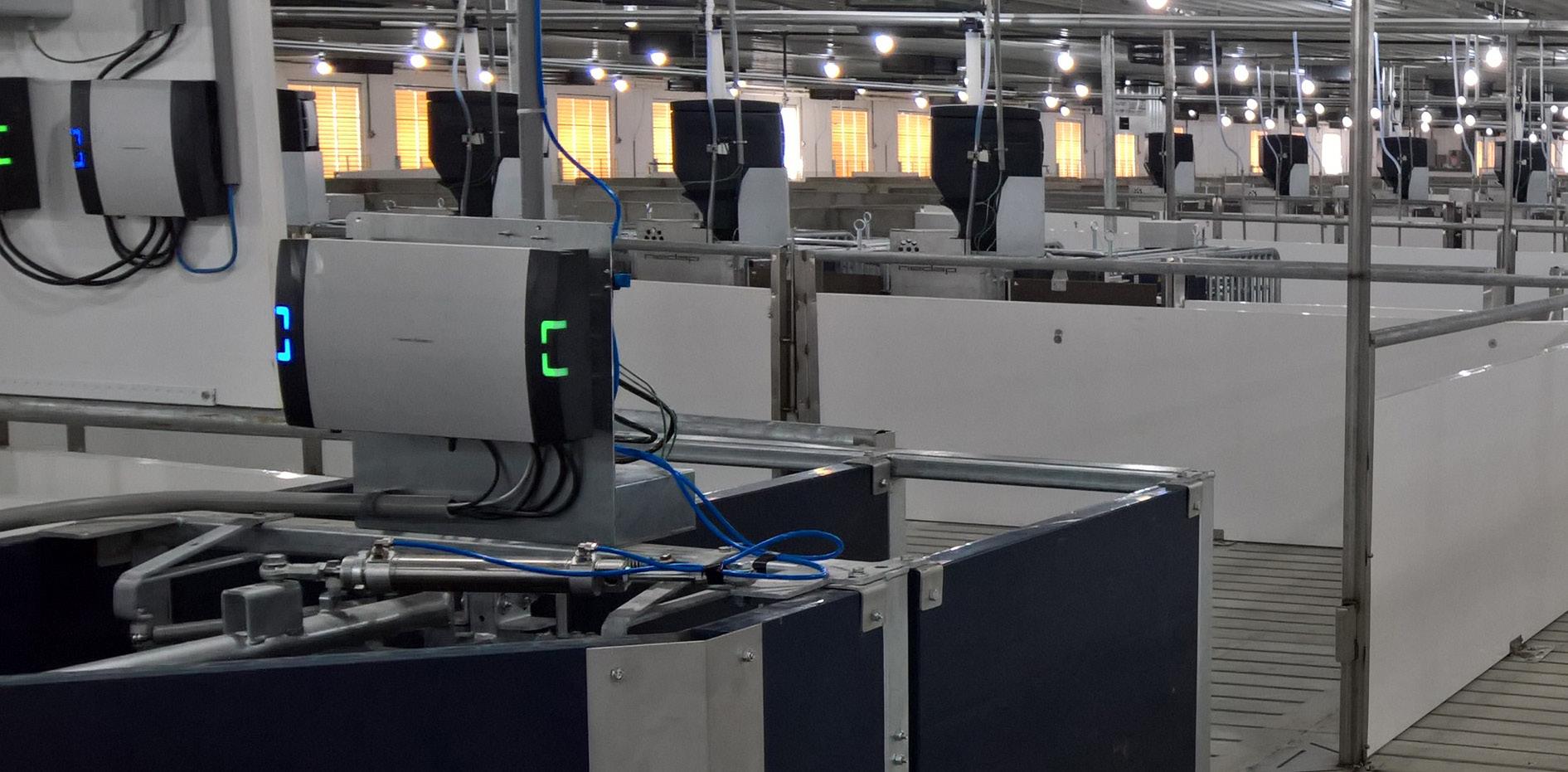
I Can vs I Can’t
This principle is the same one I use to teach my kids that it is not acceptable to automatically say “I can’t do that” when faced with a new challenge. Odds are that if they begin to face a new challenge with the attitude that they cannot do it, then they will fail. But if they believe they can
positive attitude = positive performance
When you come across challenges in a loose housing barn (and you will), if you believe there is a solution, you will find it. If you believe that the system is flawed, then you will blame that on the system, your staff, or some other element of your operation instead of looking any further for a solution.
achieve something, it is amazing how often they succeed. This is not a new idea, Henry Ford was quoted as saying “Whether you think you can, or you think you can’t— you’re right.” Although I’m sure he was not referencing sow housing, the basic principle still applies.
34
Sow Housing Will Work, Don't, You're Right.
By: Kevin Kurbis
With Group Sow Housing, Attitude Makes All the Difference
We have installed our loose housing equipment in a few barns where they started out as disasters. It was only after the replacement of the lead staff that the barn started functioning at a high level. We did not change anything in the equipment or design; we simply managed to get the people out of the barn who were quick to proclaim that loose housing could not work. Once the new employees, who believed in the system, were in place, we saw a dramatic turn around.
If you don’t want a new system to work, it simply will not work. This applies to everything in life. So if someone has made the statement that something will not work, they will do everything they can to prove that is true (sometimes without even realizing it).
When we train each staff when a new barn is built or equipped with ESF equipment, we tell them that the
system will follow the attitude that is leading it (positive attitude = positive performance).
It’s All About the Right Attitude With the Proper Design
Don’t get me wrong, there are plenty of group housing systems that are set up to fail. Without proper design, you will see major complications upon startup and years down the road. ESF equipment is important to a functional group sow housing barn, but the barn layout and pen design is even more important. When we plan a new barn, we take the time up front to make sure you are set up for success.
Even if a loose housing barn is set up to fail, a positive outlook will still help you overcome your obstacles, no matter how major they are. Group sow housing can and will work as efficiently as stall barns, and as technology rises, group housing is becoming more efficient than stall barns.

35 New Standard Hog Update 2017
Studying How Sow Weight Is Impacted by Daily Feed and SID Lysine Intake
By: Lori Thomas, PhD Candidate at Kansas State University

We wanted to understand what sows are doing in gestation. How is sow weight gain impacted by parity? Stage of gestation? What about feed efficiency?
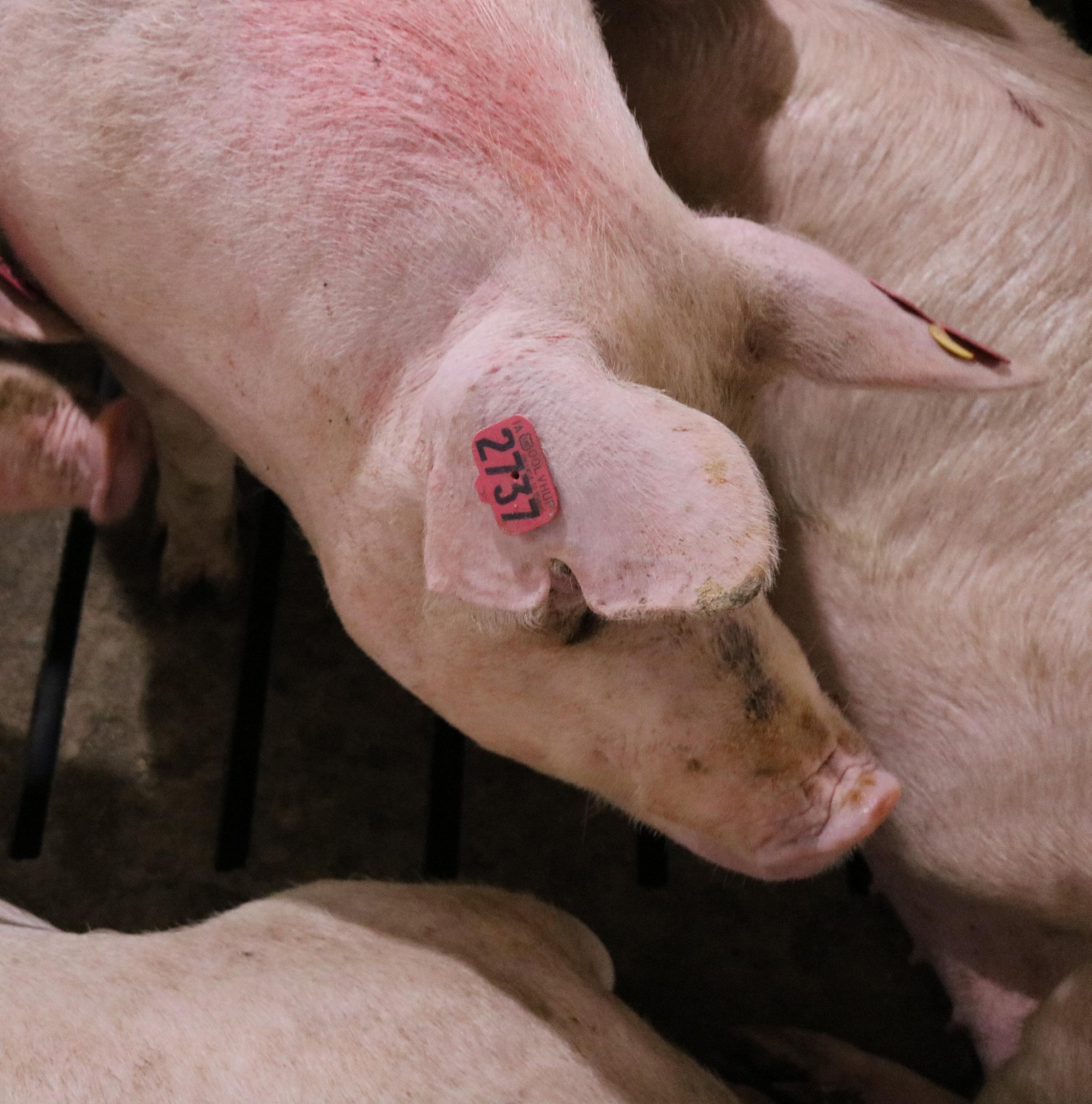
" "
I am a graduate student at Kansas State University studying swine nutrition, and I was given the opportunity to conduct research on a sow farm containing NEDAP electronic sow feeders for group gestation pens. Conducting research involving gestating sows can be a daunting task, however with all of the advancements in technology, specifically the use of ESFs, doors are being opened into areas of gestating sow research that have never been explored before.
Sow Weight and Daily Feed Intake Research
Typically, when we discuss sows, producers are concerned with farrowing rate, total piglets born, or factors impacting sow longevity. Very little attention has been focused on weight gain and feed efficiency in gestating sows. We wanted to understand what sows are doing in gestation. How is sow weight gain impacted by parity? Stage of gestation? What about feed efficiency? Answering these questions will help us determine nutritional requirements and feeding recommendations, allowing for us to really fine-tune gestation feeding programs.
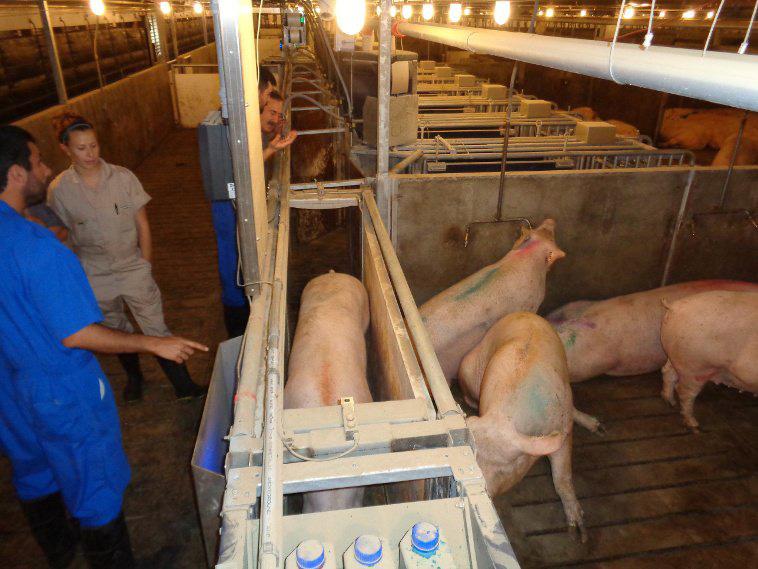
Our Findings
Perhaps the largest finding from our research was that sows and gilts did not eat the full amount of feed provided to them or gain much weight in the first 10 days or so in the pen. After the first 10 days, both sows and gilts would consume their full daily allowance of feed. There were significant changes in average daily gain in sows following the initial 10 days in the pen. Following this initial period, average daily gain remained constant, indicating the females were consistently eating and gaining for the remainder of the study. It is important to note that gilts from this farm undergo an extensive training program prior to entry into the ESF system. Our results share a very important message that even with a good training program, gilts and sows appear to struggle within those first few days of introduction into the group gestation pen.
Impact of SID Lysine Intake on Sow Weight Gain and Reproductive Performance
For my MS degree, I collected feed intake and body weight data from 861 gestating sows from a commercial sow farm utilizing ESF technology. The NEDAP system in this barn is unique in that it contains two feeding lines in selected pens. In addition, research pens contained scales in the alleyways that returned to the pens following the feeding stations (these sow weight monitoring systems were designed by New Standard). Therefore, I was able to obtain daily intake and daily body weights on sows, throughout the course of gestation.
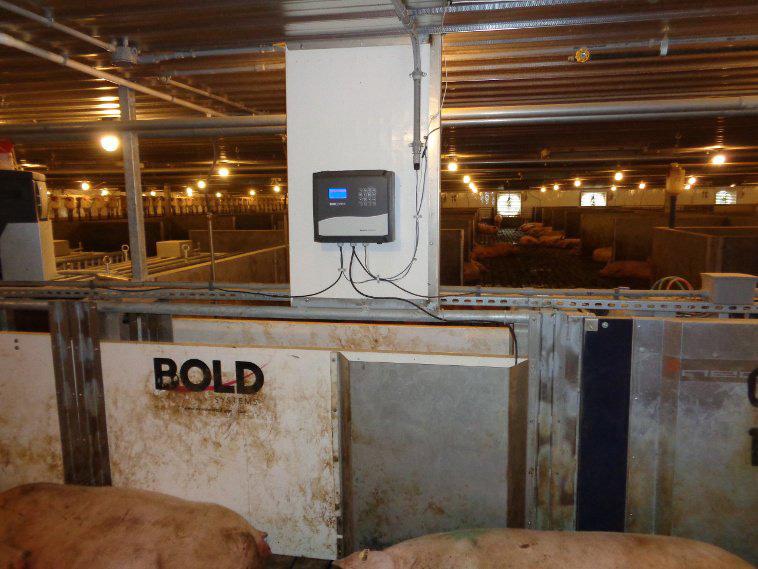
With the excitement and success that was generated from the first trial, I have decided to return to the same sow farm to conduct another study. This time we are utilizing the two feed lines and feeding different levels of lysine (an essential amino acid) to gilts and sows throughout the course of gestation. Our objective is to evaluate the impact of SID lysine intake during gestation on weight gain and reproductive performance of gilts and sows. Daily body weights and intakes will be collected again throughout the course of gestation and individual piglets will also be weighed in the farrowing house.
This type of research would not be possible without NEDAP and New Standard, and we are very excited to have the opportunity to conduct another study. We are eager for the outcome of the trial.
37 New Standard Hog Update 2017
estock management
Step forward for calm group pens
When choosing a feeding system for your new or remodeled sow barn, look at the options from all points of view. Walk-in/back-out stalls might look easy to you. But how do they look from your sows’ perspective? Would you want to back away from the dinner table through a hungry crowd trying to take your place? Or would you prefer to walk away from the crowd and find a place to nap?

At Nedap Livestock Management, we think minimizing congestion at the feeder entrance is a key to calm, productive groups, and we think your sows would agree. That’s why the feeders in our automated management systems are designed with front exits to encourage one-way traffic through pens.
LEADING THE WAY IN AUTOMATED ANIMAL MANAGEMENT
We didn’t come up with this design by chance. We were a pioneer in precision sow feeding, and our first feeder had a combined entrance and exit. However, we saw how this design intensified sow aggression because sows clashed while trying to get into or out of feeders. We also saw how dominant sows guarded the feeder if given the chance.
First use of RFID technology for dairy cows 1974 1982
Automated heat detection for sows 1992


Porcode Electronic Sow Feeder (ESF)
1998
Sow feeding software program able to alert producers via text or email when a sow needs attention 2008 2011
Central separation for sows
Pig sorting technology for grow/finish operations
Pig performance testing for automated data collection 2012 2014 Farrowing feeding system
Weight monitoring option for the ESF system 2017
38
l
1982
i v
Today
WHAT’S BEST FOR THE SOW IS BEST FOR HER PRODUCTIVITY
At Nedap, we put the sow’s needs first when we designed our electronic sow feeding system. When a sow enters a Nedap feeder, the gate locks behind her. She can’t be touched or disturbed while she’s eating, so she doesn’t feel the need to choke down or guard her feed. When she’s done, she exits the feeder from the front – away from the group – and returns to the pen without interacting with sows waiting to eat.

The only way the sow can get back to the feeder entrance is to take a horseshoe-shaped lap around the pen. This walk could take 5 minutes or longer, especially if she stops to get a drink or linger by the boar in his pen with automated heat detection. With a full belly and no urge to guard her feed, the sow is likely to find a place to lie down and digest her meal, forgetting about the feeder until she’s hungry again.
Meanwhile, another sow will have entered the feeder behind her, keeping the flow moving at a steady pace, no matter the time of day.
When choosing a feeding and management system for your new or remodeled sow barn, be sure to think about what’s best for your sows. If you choose a system that lets your sows move and eat without conflict, you will be rewarded with sows that are calm, comfortable and more productive.
NEDAP ELECTRONIC SOW FEEDING –THE BENEFITS




• Designed with sows’ needs in mind and with more than 35 years of sow management experience
• Forward exit eliminates conflict at feeder entrance
• Sows are relaxed and eat without interruption
• Pen design eliminates dominant sows’ drive to guard feed source
• Can be combined with other Nedap solutions as part of a complete barn-management system
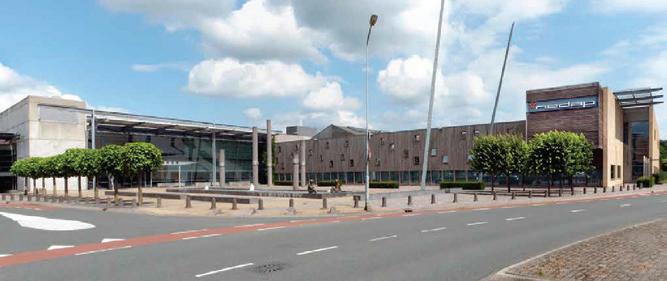

MEET OUR TEAM
Nedap Livestock Management 401 Edgewater Place Wake eld MA 01880 USA
Nedap Livestock Management 401 Edgewater Place Wakefield MA 01880 USA
T (712) 435 7546
E livestock-us@nedap com
T (712) 435 7546 E livestock-us@nedap.com
twitter.com/NedapLivestock facebook.com/NedapLivestockManagement youtube.com/user/NedapLM nedap-livestockmanagement.com/pig-farming
twitter com/NedapLivestock facebook.com/NedapLivestockManagement youtube com/user/NedapLM nedap com/livestockmanagement
For more information visit nedap-livestockmanagement.com/ pig-farming
39 New Standard Hog Update 2017
Rich Lepper Application Manager
Tim Shanks IT/Project Manager
Brad Carson Vice President Nedap Livestock Management USA
Robert Drew Sales Manager USA Rene Weernink Sales Manager Canada
North American Livestock Management Sales & Support Team
l i v estock management
Thank you, New Standard Group, for being a valued partner.
How Many Sows Can I Feed on One ESF Station?
This is often one of the first questions we are asked when talking through an ESF group gestation pen design. We completely understand the importance of this question because as producers, you have to monitor your overhead and operating costs closely in order to turn a profit. While there is significant importance behind this question, we challenge everyone to not only focus on the costs in your barn, but also the impact each aspect of your barn has on your production totals. Learn more on how to calculate the value each of your ESF stations add to your production.
Issues With Focusing on Capacity
It is a common urge to want to put as many sows as possible on an Electronic Sow Feeding station. After all, this should reduce the number of stations you include in your group gestation pen design, thereby reducing the overhead and operating costs in your barn. In practice, the value of each ESF station is more complicated. At a certain point, the more sows you add to a station, the fewer live born piglets each sow will likely produce. No matter how large your pens are, adding too many sows per station causes ever increasing stress and competition among the group during feeding times. The stations will be backed up and the girls waiting will jostle for position until the stations open up for the next pig. Prolonged exposure to this stress will build up and can significantly reduce your birth rates.
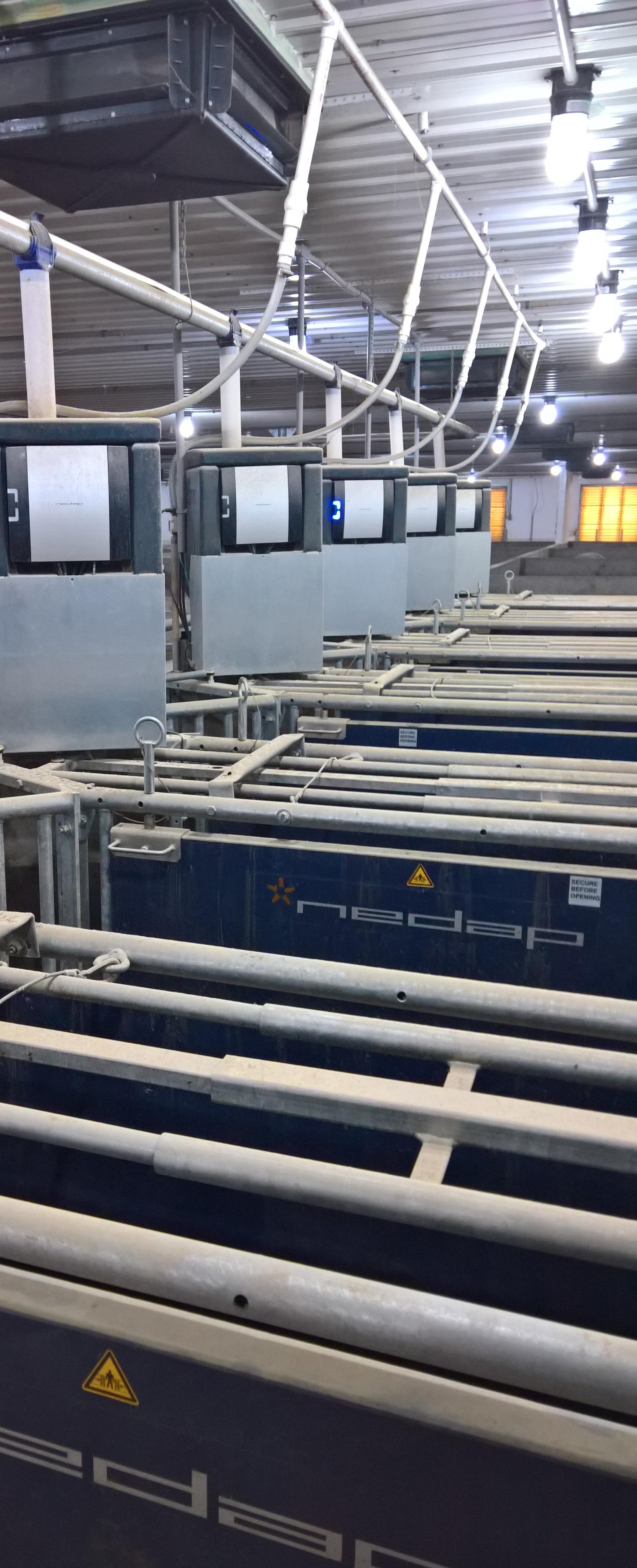
Focus on Piglets, Not Sows
Instead of focusing on the number of sows per station, we need to be calculating the number of piglets weaned per station. From our experience with previously designed barns, we have found that there is a point when adding more sows per station increases your feed costs without making an equal or greater impact on your total production. See the following example for the reasoning behind this.

Let’s say you have one pen with 45 sows per ESF station and another with 80 sows per station. If the 45 sows average 32 piglets each per year, and the 80 sows only average 28 piglets each per year, you might have more overall piglets, but since each sow is producing less, your cost per piglet is skyrocketing.
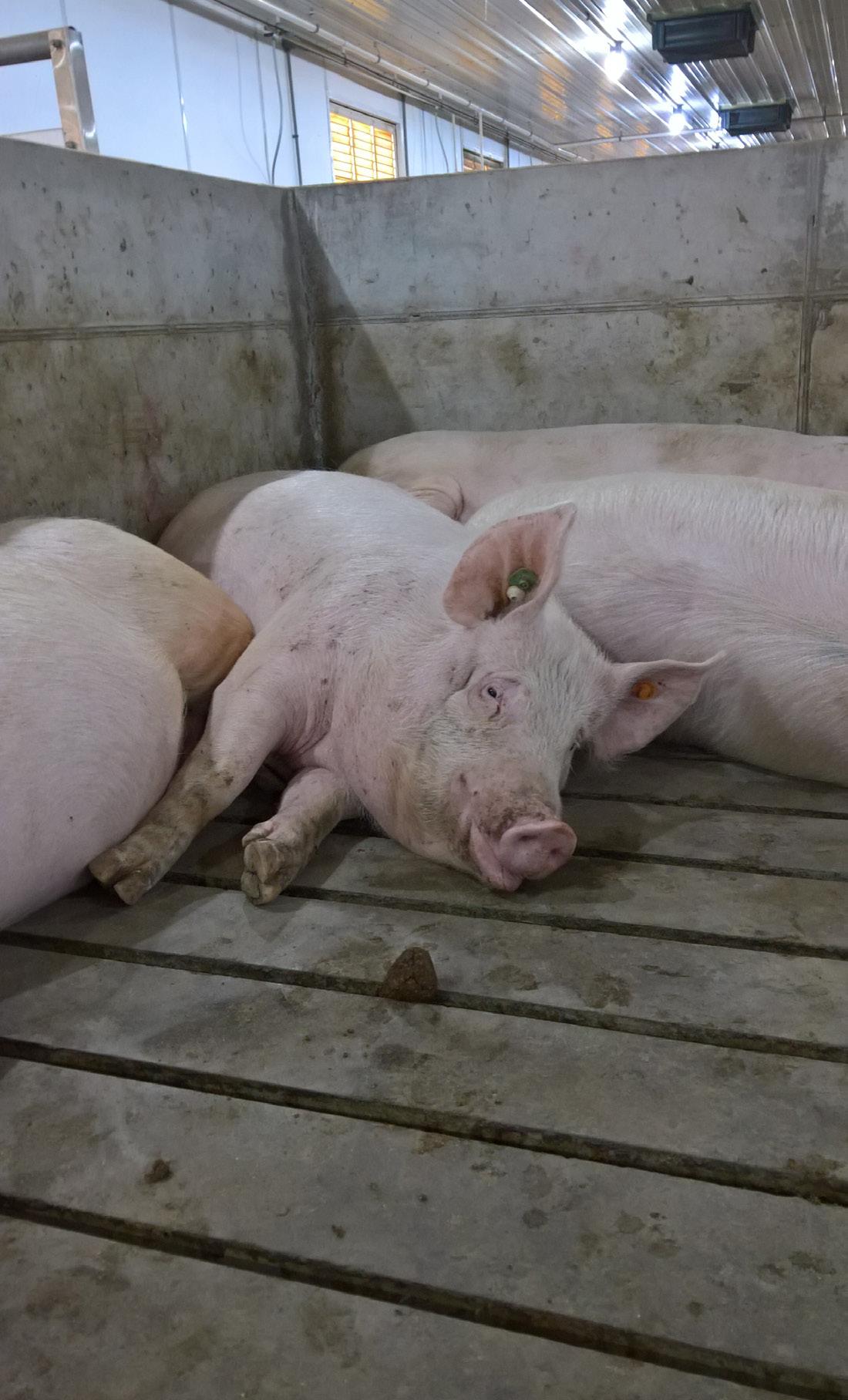
station beyond recommended limits, you will most likely decrease the number of piglets per sow. That means you will need more sows to meet your production goals or you will have to lower expectations. If you raise the number of sows and farrowings per week, you will in turn also increase the number farrowing stalls you need to construct in order to achieve the same amount of production as if you had fewer sows per station. If you can lower your number of farrowings per week or increase overall piglet production by adding more ESF stations, you are going to increase profitability in the most expensive part of your barn.
In this example, you have 78% more sows per feed station but you have only increased your piglet production by just 56% per ESF station.
Now, we do understand that extra equipment costs more money, but your barn does have limited space. In the scenario above, if you have a 5,500 head sow barn, and you design for 80 hogs per ESF station, your barn would produce 154,000 total piglets per year. If in the same barn you design for only 45 sows per station on average, that same barn has definite potential to produce 22,000 more piglets each year for the same feed cost.
*Barns that have too many sows per station may produce more than this example but that is an exception to the rule 5,500 x 28 = 154,000 piglets per year 5,500 x 32 = 176,000 piglets per year
Sometimes, the better way to save money is to invest more into equipment to reduce the stress among your sows and increase birth rates than to put as many sows on an ESF station as possible. In our design experience, we have found the best target to be between 45 – 52 sows per ESF station, and if the hog barn design has separate gilt pens, they should have between 40 – 45 gilts per station.
Farrowing Crates Are the Most Expensive Place on the Farm
We know that the farrowing crate is the most expensive space in any barn construction and operation. We have already shown that if you increase the number of sows per
The numbers used in this example are taken from general observations of current operating ESF Barns. We recognize that each barn is unique and will produce different results. When we sit down to put together a hog barn design, we take into consideration all of the different variables that come into play in each production. Each barn is a custom design to fit the needs of each producer and their barn staff.
41 New Standard Hog Update 2017
Example
45 sows x 32 piglets each = 1,440 piglets per year 80 sows x 28 piglets each = 2,240 piglets per year
42 Word Search More fun on page 15 FortheKids BARN BARROW BOAR CULLING FARROW FEEDER FINISHING GILT HAMPSHIRE PIG PIGLET PRODUCER SOW WEANLING
Even in the best-managed barns, one out of three sows is either over or under her ideal farrowing weight which of course affects her litter size and viability. These less productive sows cost the industry almost $30,000 for a group of 1,000 sows. The task before every pork producer is how to get their farrowing rates up and their costs down. The best way to do this is by incorporating state of the art sow weight monitoring into your electronic sow feeding systems.
The Age-Old Problem
Chances are, if you are a pork producer, you know you are overfeeding some sows and underfeeding others. Underfeeding or overfeeding will almost always lead to underproduction in your pigs. To achieve a healthy period of gestation, a sow requires enough nutrition to support both her own growing needs and those of her piglets. A general rule of thumb is that 70% of the feed a sow takes in goes to maintaining her body mass and 30% goes to her developing piglets. If that sow is being underfed, you will likely see a reduced farrowing rate, small piglet size and/or poor piglet health, or poor health in the sow herself.
Why Don’t Back Fat Measurements Work?
In an effort to provide each sow what she needs, many producers have turned to visual or mechanical measures such as back fat and body condition scores. These are great indicators, but they are only part of the whole picture. Without weights, these are just educated guesses at best.
There is a huge amount of variation in sows with the same back fat measurement. In fact, some report more than 77 pounds of difference in sows with the same body condition score. Over the course of a sow’s gestation period, that could be as much as a 100 pound difference between the feed she needed and the feed she received. Think of the impact that overfeeding or
underfeeding could have on her and her piglets; not to mention your bottom line as a producer. Feed is one of the more expensive investments you make as a pork producer, and you want it to be money well spent.
Sow Weight Monitoring: Part of the Hog Barn Design
Without a doubt, sow weights provide the best individual standard for determining feed requirements. It used to be that sow weights were just too complicated to attain to serve as a regular sow measure. For one, gathering weights stressed the girls out because there was no way to get their weights unobtrusively. Fortunately the tides are turning with state of the art hog barn designs and improving technologies.
With customized sow weight monitoring built into the infrastructure of a hog barn design, you will see significant gains in production, savings in feed, and healthier pigs. You can make it easy to collect sow weights by designing the weight monitoring system into the Electronic Sow Feeding process. Weights are collected as your girls walk through the sow separation system, causing them no stress and giving you the data you need to make informed decisions. Additionally, these regular weigh-ins mean that you have the opportunity to spot problems in your pigs before you lose money, or pigs.
43 New Standard Hog Update 2017

44 www.newstandard-group.com New Standard has three regional offices to bring their expertise in sow and poultry housing directly to you. New Standard US Contact Us Tim Kurbis: 605-496-9696 info@newstandardus.com New Standard US 1200 E Robur Dr. Sioux Falls, SD 57104 New Standard Ag Contact Us Kevin Kurbis: 204-485-4600 kevin@newstandardag.com New Standard Ag Inc 961 Harriot Rd St. Andrews, MB R1A 4H6 New Standard West Contact Us Kees (Kase) van Ittersum: 403-650-5051 kase@newstandardwest.com New Standard West Site 12, RR#6, Box 49 Calgary, AB T2M 4L5













 Kristina M. Horback, Ph.D. Assistant Professor at UC Davis
Kristina M. Horback, Ph.D. Assistant Professor at UC Davis
























 Rugged construction and design
Durable Traction Coating
Larger Diameter
Gate Rollers
Precision Assembly with oversized cylinders
Rugged construction and design
Durable Traction Coating
Larger Diameter
Gate Rollers
Precision Assembly with oversized cylinders












 With advice from Steve Horton
With advice from Steve Horton


























